LECTURE
1.
THE
WORD AND ITS MEANING
OUTLINE
-
The
word and its main characteristics. -
Types
of meaning. -
Semantic
changes and their causes.
-
The
word and its main characteristics.
Lexicology
is a branch of linguistics that deals with the vocabulary of the
language and characteristics of words as the main lexical units.
Lexical units comprise words and set expressions, or groups of words
of fixed character.
There are
over 200 definitions of a word but none is generally accepted. The
word reflects world mapping which is culturally and nationally
specific. Word use is also pre-determined by person’s social and
educational status, gender, age, etc.
The word
performs the following functions:
-
denotational
(denotes things, qualities, actions,etc); -
generalizing
function (e.g. tree, house, animal); -
emotive
function (expresses our feelings and emotions); -
structural
function (performs a certain syntactic function, is a part of a
sentence).
The word is
the smallest meaningful unit possessing the following features:
-
isolatability,
i.e. ability of a word to function in communication alone, to make
a sentence, e.g. ‘Help!’ This distinguishes a word from another
meaningful unit – a morpheme, which cannot be used in isolation.
It can function only as a part of a word. -
indivisibility,
i.e. a word cannot be further divided without breaking its meaning.
Cf. asleep – a (sound) sleep, alive – a (quiet) life. -
positional
mobility, i.e. a word can change its position in a sentence. E.g.
Suddenly they came up to a house. They came up to a house suddenly.
Up to a house they suddenly came.
The word is
a two-facet unit combining meaning and form. The relationship between
the two is denoted by the term motivation. If the connection between
the meaning of a word and its form is clear and the form helps us to
understand the meaning, the word is considered motivated. If the
connection is conventional, the word is said to be non-motivated at
the present stage of language development.
There are
three types of motivation:
-
Phonetic
, the sound form of the word helps us to understand its meaning,
e.g. bang, bump, hiss, cuckoo, etc. -
morphological,
the morphemic composition of a word helps to understand its meaning,
e.g. ex+ noun = former …; re+ verb = do again; verb+er = agent,
doer of the action. -
figurative
meaning of a word becomes clear through its direct meaning, e.g. the
leg of the table, the foot of the mountain, the eye of the needle.
The
meaning is not homogeneous. It is a system of systems:
1)
It combines lexical and grammatical meanings, e.g. actress is a
personal noun.
2)
Lexical meaning includes denotative and connotative ones.
3)
Denotative meaning is conceptual (what a word denotes), it is
divided into semantic
components
called semes, e.g. Father is a male parent. Denotative components may
be
culturally predetermined (cf. winter in Siberia and in Australia, it
is a season
between
autumn and spring but all other characteristics are different:
duration,
temperature,
etc.).
4)
Connotative meanings express the speaker’s attitude to the subject
of speech and may
be
as follows:
-
stylistic:
chap, fellow, associate; child, infant, kid; -
emotive:
cool, awesome, terrific; -
expressive:
to trudge, to march, to gobble; -
evaluative:
clever, silly, good, bad(rational evaluation), scoundrel
(emotional evaluation); -
associative
(a fir-tree – forest, New Year); -
national
and cultural (kilt – Scots); -
pragmatic:
Can you open the door?
5)
A word may be polysemantic, i.e. it may have several interrelated
denotative
meanings:
-
One
of the meanings is called primary, this is the meaning in which the
word made its first appearance in the language, all the other
meanings which developed later are called secondary, e.g. chair as a
piece of furniture (primary), chair as the head of some meeting,
conference or chair as a department (secondary meanings). -
One
of the meanings is central, others are peripheral. As a rule,
primary and central meanings coincide but it is not necessarily so.
In the course of language development a secondary meaning may become
the central one ousting the primary meaning to the periphery, e.g.
revolution: primary meaning is that of rotary movement, revolving,
secondary – social change (now central). -
Meaning
can be direct and indirect (figurative, transferred), e.g. white
collar, blue collar, smoke screen, etc.
III.
Semantic changes and their causes.
1.Specialization,
or narrowing of meaning
e.g.
garage – a safe place
meat
– any food
2.Generalization,
or widening of meaning
e.g.
ready (in O.E. – ready for a ride, now – ready for any activity)
arrive
– to land at a shore
3.Elevation
of meaning (getting better, going higher)
e.g.
queen (in O.E. – woman)
knight
(in O.E. – young servant).
4.Degradation
of meaning (getting worse, lower)
e.g.
a spinster – a woman that spins wool
idiot
– a private person
5.
Transference of meaning. The name of one thing is used to name some
other things.
Transference
is further subdivided into metaphor, metonymy and euphemism.
-
Transference
of meaning based on likeness is called a metaphor. Metaphors can be
based on likeness of form (a head of cabbage), of position (the foot
of the mountain), function (Head of the Department), size, quantity
(ocean of troubles, storm of applause), etc. Sometimes a combination
of several features makes up the foundation for a metaphor (a leg of
a table – function, position, shape). Metaphors may involve
transition from proper names to common ones, e.g. a Don Juan,
Apollo, Vandals, Hooligans. -
Transference
of meaning based on associations of contiguity (being together) is
called metonymy. We can use the name of a container for the thing it
contains (Will you have another cup?), instrument for the agent (His
pen knows no compromise), the place for the people who live or work
there (Kharkiv greets the guests. The Kremlin agrees to the treaty),
the name of a person for the things s/he made (He reads Byron), the
name of a part for the whole (Who’s the moustache?) -
Transference
of meaning dictated by social conventions, norms, rules of behavior.
A word or a word combination is used instead of the other word that
is offensive, rude, or taboo.
e.g. to
die: to perish, to pass away, to join the silent majority, to meet
one’s maker, to be with the angels, to cross the Great Divide, etc.
toilet: WC,
bathroom, the necessary facilities, powder room, ladies/ gents,
public conveniences, cloakroom, throne room, porcelain collection,
Windsor Castle, etc.
Causes
of semantic changes may include linguistic and extra-linguistic ones.
The
latter are connected with social, political, economic, cultural and
scientific development.
e.g.
computer, space, feedback, bikini, villain, boor, etc.
The
former embrace differentiation of synonyms (e.g. time and tide),
borrowings (hound and dog), preserving the old meaning in idioms
(love token, token of respect), etc.
LECTURE 2.
PHRASEOLOGY
-
Set
expressions, their features and origin. -
Classification
of phraseological units.
-
Set
expressions, their features and origin.
Set
expressions are stable ready-made units with fixed integrate
structure. They are contrasted to free phrases and semi-fixed
combinations. A free phrase permits substitution of any of its
elements without any semantic change in the other element, e.g. to go
early: to work, get up, move, etc. early: to go late, quickly, down,
etc.
In
semi-fixed combinations there are some boundaries for the
substitution, e.g. go to school (market, college, court, etc.) is
used only with nouns of places where definite actions are performed.
Features
that make set expressions stable:
-
euphonic;
-
imaginative;
-
connotative.
Euphonic:
rhythm, rhyme, alliteration, e.g. safe and sound, stuff and nonsense,
by hook or by crook.
Semantic
stylistic features: simile, contrast, metaphor, synonymy, antonymy,
e.g. as like as two peas, as old as hills, more or less, from
beginning to end, a lame duck, arms race, to swallow a pill, proud
and hauty.
A bit of
expressions are connected with different spheres of people’s life,
nature, etc.
-
nature,
e.g. out of the blue, as welcome as snow in May, to rain cats and
dogs, etc. -
agriculture,
e.g. plough the sand, reap a rich harvest, sow wild oats, etc. -
sports,
e.g. fair play, to kick a goal, etc. -
mythology,
e.g. the apple of discord, Achilles’ heel, etc. -
the
Bible, e.g. Solomon’s judgement, forbidden fruit, etc. -
folklore,
e.g. peeping Tom, Calamity Jane, etc. -
literature,
e.g. to fight the windmills, a green-eyed monster, etc.
-
Classification
of phraseological units.
There
are different approaches to studying and classifying phraseological
units.
-
The
classification of V.V.Vinogradov is synchronic and semantic. It is
based upon the type of motivation. He distinguishes:-
phraseological
fusions, e.g. tit for tat. They represent the highest stage of
blending, are not motivated nowadays, are specific for every
language and cannot be literally translated; -
phraseological
unities , e.g. to know where a shoe pinches, to rise to the bait,
etc. They are clearly motivated, some of them are easily
translated and even international; -
phraseological
combinations, e.g. to meet the demands, to make friends. They are
not only clearly motivated but also contain one component used in
its direct meaning (demands, friends).
-
2. Larin’s
classification is also semantic but diachronic. He believes that each
unit goes through three stages in its development. First it is a free
word combination, then a motivated metaphoric phrase and then an
idiom with lost motivation, e.g. to give a sack, to give a cold
shoulder, to dance attendance on smb., etc.
Semantic
classifications of Vinogradov and Larin are open to criticism since
the degree of motivation may be different for different speakers
depending on their knowledge of history, customs and traditions,
level of education, etc. So they are subjective, not reliable enough.
-
N.Amosova’s
approach is contextological. She defines phraseological units as
units of fixed context characterized by a specific word-order and
peculiar semantic relationship between the components.
Phraseological units are divided into phrasemes and idioms.
Phrasemes are always binary. One of their components has a
phraseologically bound meaning, the other serves as the determining
context, e.g. small change, small hours, small talk. In idioms the
new meaning is created by the whole, each element having its own
meaning weakened or lost. Idioms may be motivated and demotivated. -
Koonin’s
classification is functional: depends on the functions
phraseological units fulfil in communication. There may be: a)
nominating (e.g. a man of straw, a bull in a china shop); b)
nominative communicative (verbal), e.g. to go round the bush, to
pull one’s leg, etc.; c) communicative (sentences by form), e.g.
Curiosity killed the cat; d) interjectional, e.g. Good heavens, a
pretty kettle of fish, etc. Further classification depends on
whether the units are changeable or unchangeable, what their
structure is, etc.
LECTURES
3-5.
WORD-BUILDING.
STRUCTURE OF WORDS.
OUTLINE
-
Structural
types of words. -
Affixation.
Classification of affixes. Suffixes and prefixes. -
Conversion
(zero derivation). -
Compounding.
Classification of compounds. Criteria of compounding. Borderline
cases (semi-affixes). -
Shortening.
-
Abbreviations.
-
Minor
types of word-building.
Соседние файлы в предмете [НЕСОРТИРОВАННОЕ]
- #
- #
- #
- #
- #
- #
- #
- #
- #
- #
- #
11.02.2016113.15 Кб4MB.doc
Слайд 1Lecture 3
Semantic Structure of the Word and Its Changes
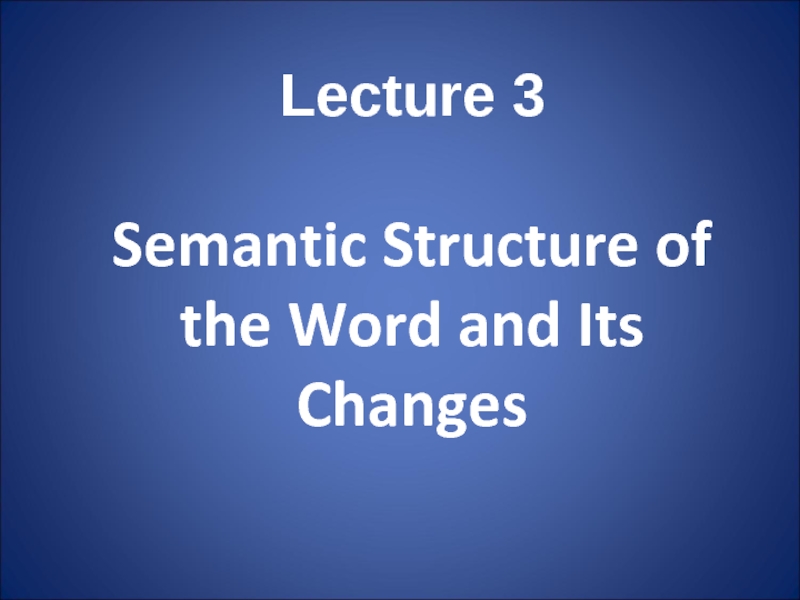
Слайд 2Plan:
Semantics / semasiology. Different approaches to word-meaning.
Types of word-meaning.
Polysemy. Semantic
structure of words. Meaning and context.
Change of word-meaning: the causes, nature and results.
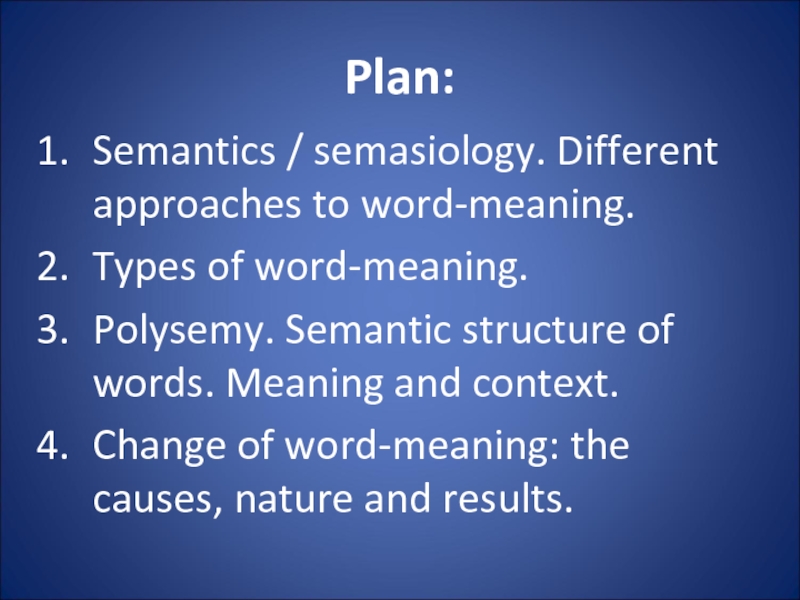
Слайд 3List of Terms:
semantics
referent
referential meaning
grammatical meaning
lexical meaning
denotational meaning
connotational meaning
polysemantic word
polysemy
lexical-semantic variants
basic meaning
peripheral
meaning
primary meaning
secondary meaning
radiation
concatenation
lexical context
grammatical context
thematic context
ellipsis
differentiation of synonyms
linguistic analogy
metaphor
metonymy
restriction of meaning
extension of meaning
ameliorative development of meaning
pejorative development of meaning
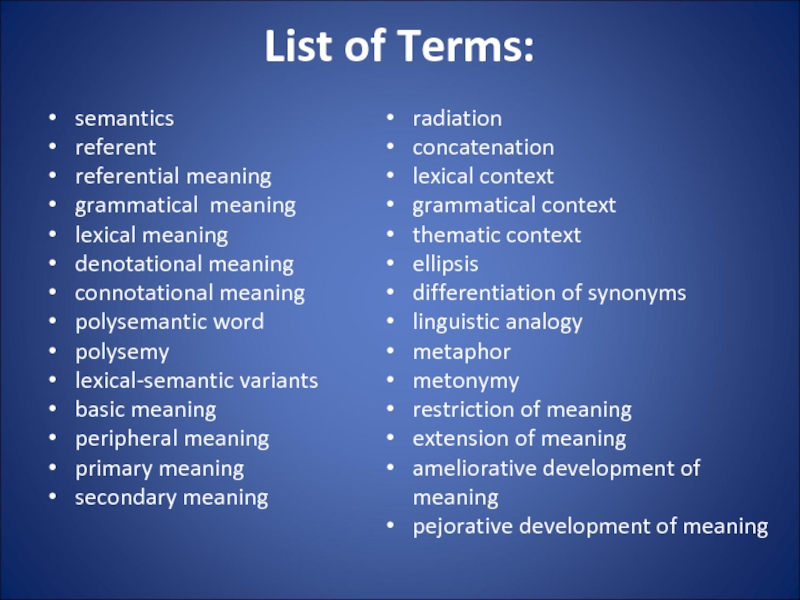
Слайд 4
It is meaning that makes language useful.
George A. Miller,
The science of word, 1991
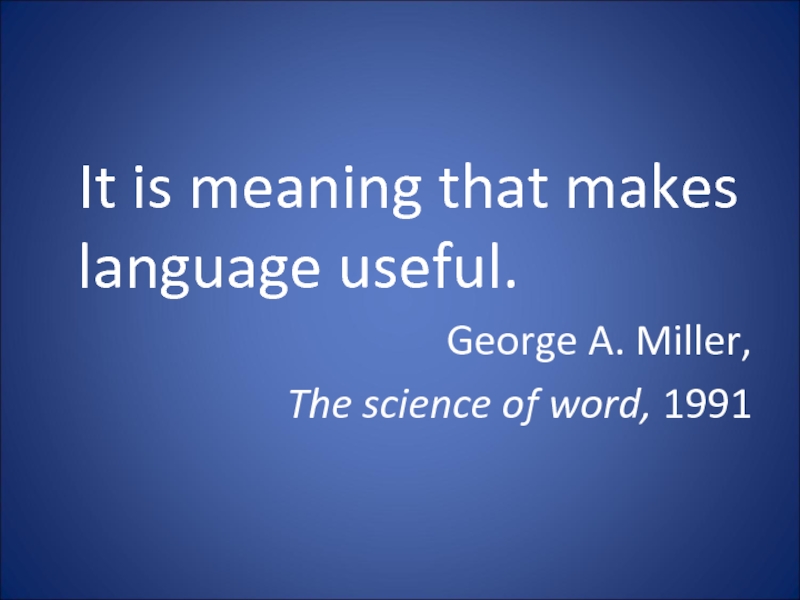
Слайд 5
1. Semantics / semasiology. Different approaches to word-meaning
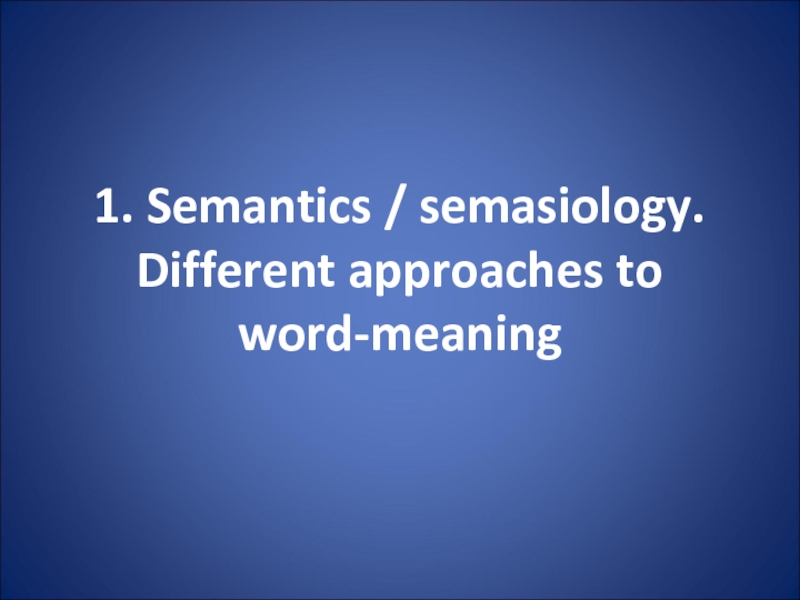
Слайд 6
The function of the word as a unit of
communication is possible by its possessing a meaning.
Among the word’s various characteristics meaning is the most important.
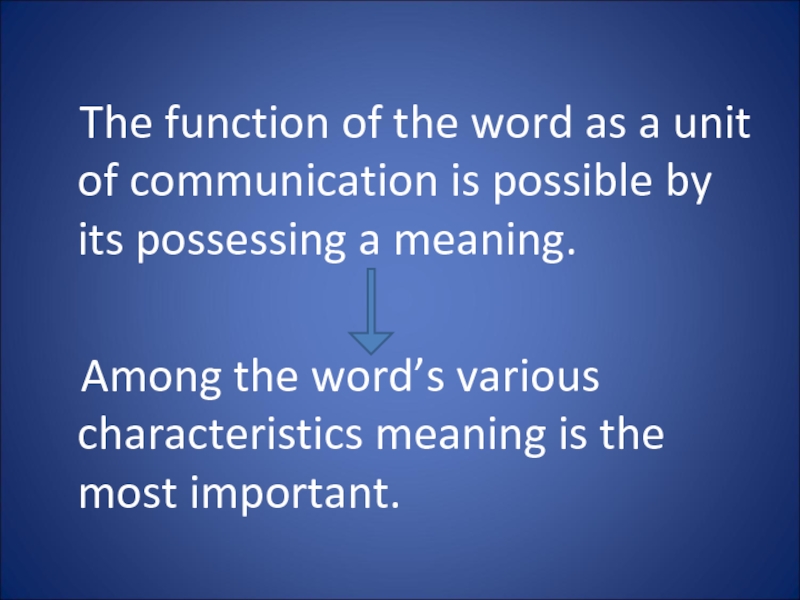
Слайд 7
«The Meaning of Meaning» (1923) by C.K. Ogden and I.A. Richards
– about 20 definitions of meaning
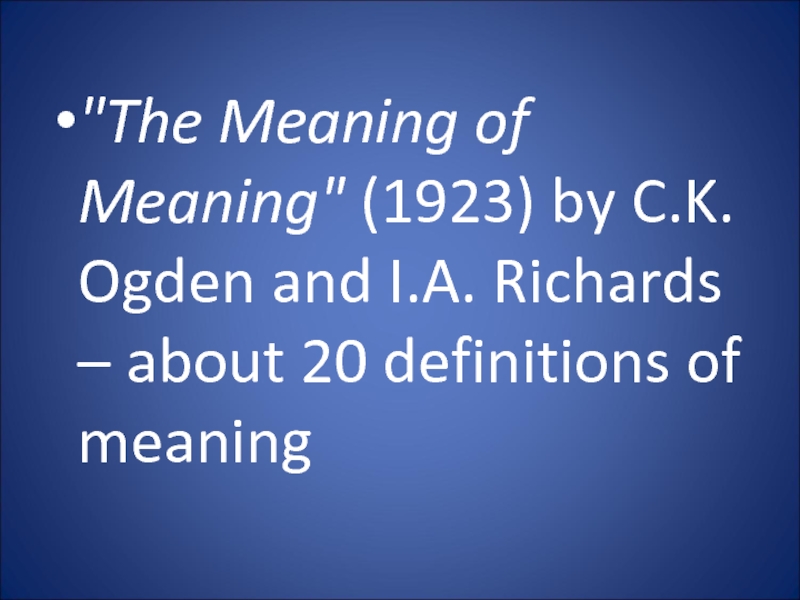
Слайд 8Meaning of a linguistic unit, or linguistic meaning, is studied by
semantics
(from Greek – semanticos ‘significant’)
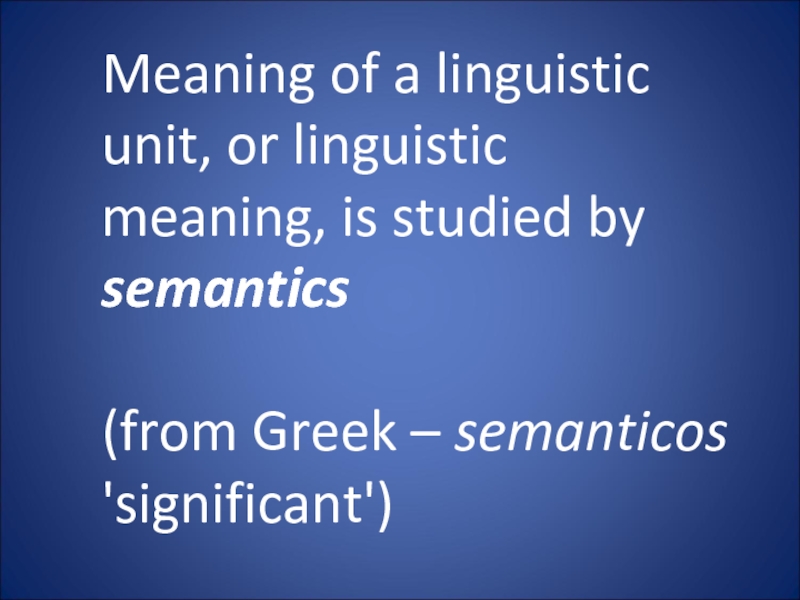
Слайд 9
This linguistic study was pointed out in 1897 by
M. Breal

Слайд 10
Semasiology is a synonym for ‘semantics’
(from
Gk. semasia ‘meaning’ + logos ‘learning’)
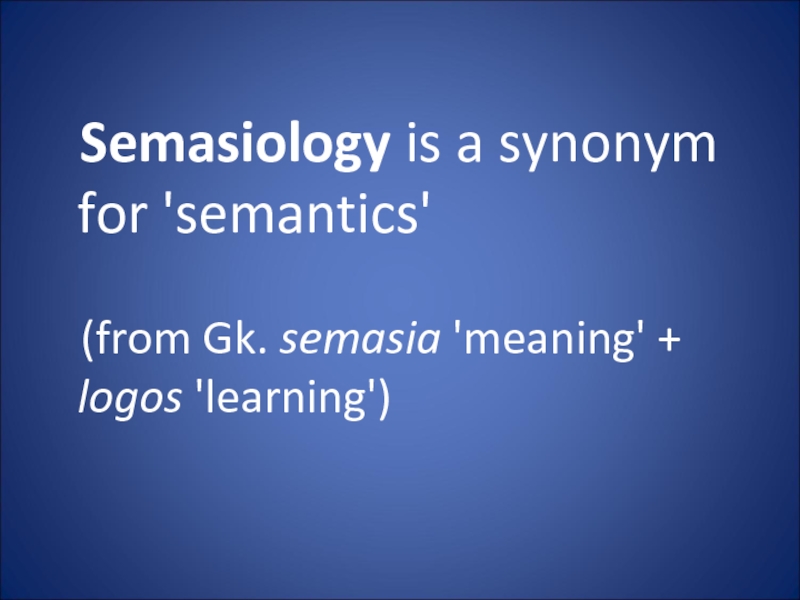
Слайд 11Different Approaches to Word Meaning:
ideational (or conceptual)
referential
functional
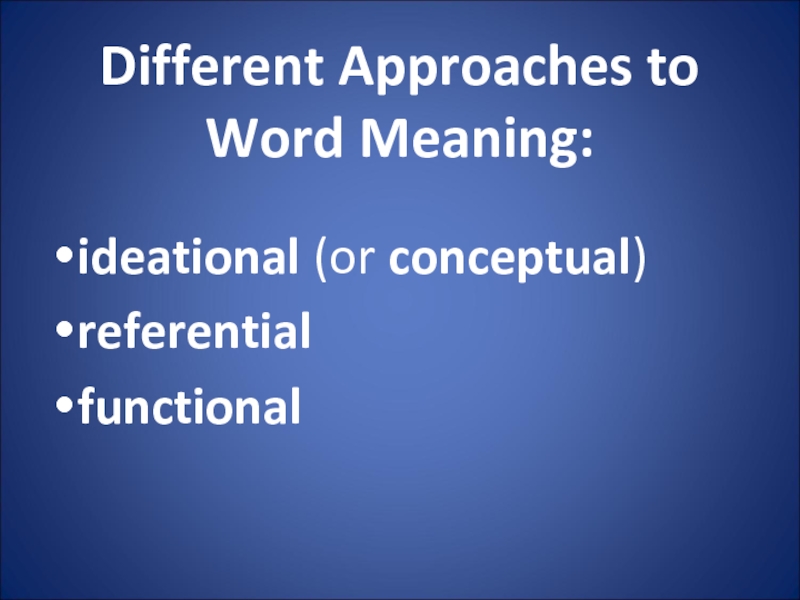
Слайд 12
The ideational theory can be considered the earliest theory
of meaning.
It states that meaning originates in the mind in the form of ideas, and words are just symbols of them.

Слайд 13A difficulty:
not clear why communication and understanding are possible if
linguistic expressions stand for individual personal ideas.

Слайд 14Meaning:
a concept with specific structure.
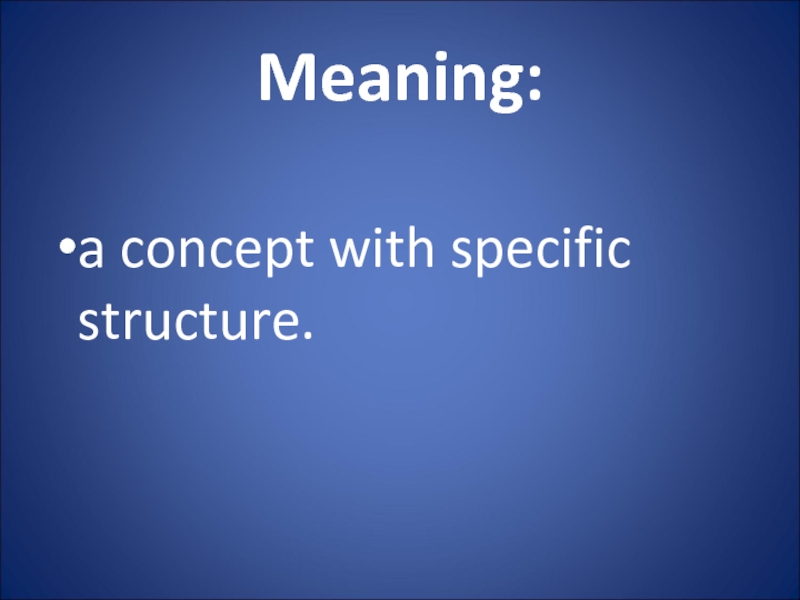
Слайд 15
Do people speaking different languages have different conceptual systems?
If people
speaking different languages have the same conceptual systems why are identical concepts expressed by correlative words having different lexical meanings?
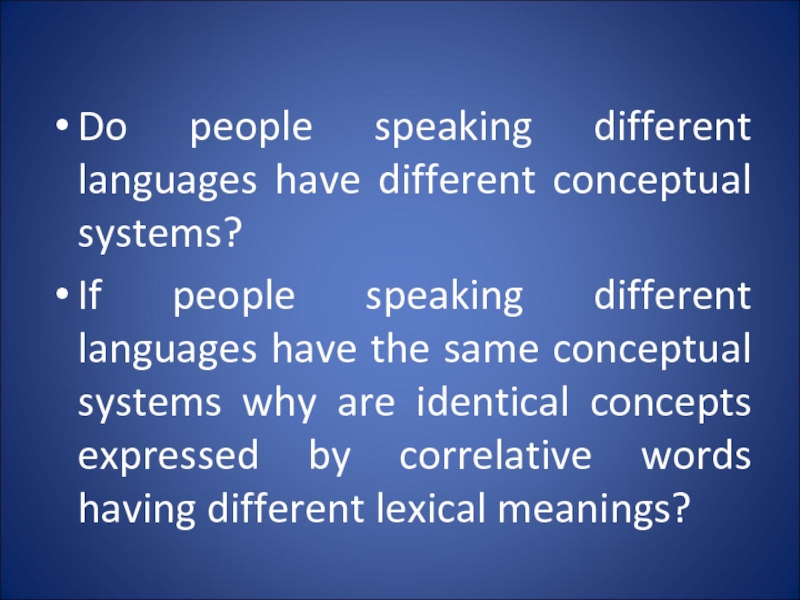
Слайд 16
finger ‘one of 10 movable parts of joints at the end
of each human hand, or one of 8 such parts as opposed to the thumbs‘
and
палец ‘подвижная конечная часть кисти руки, стопы ноги или лапы животного’
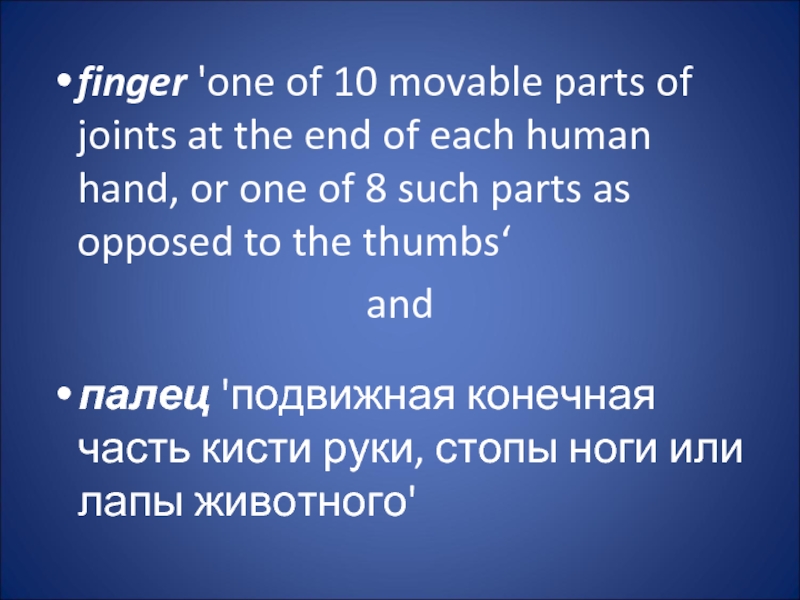
Слайд 17
Referential theory is based on interdependence of things,
their concepts and names.
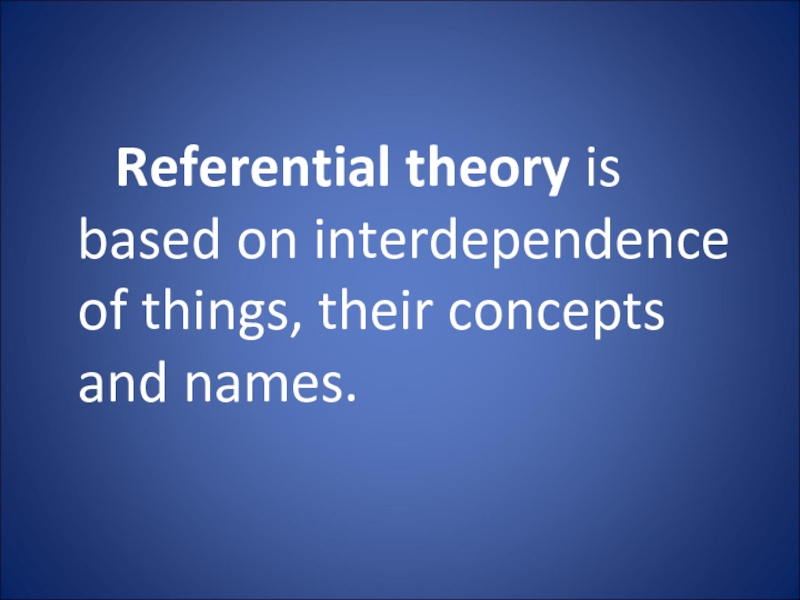
Слайд 18
The complex relationships between referent (object denoted by the
word), concept and word are traditionally represented by the following triangle:
Thought = concept
Symbol = word Referent = object
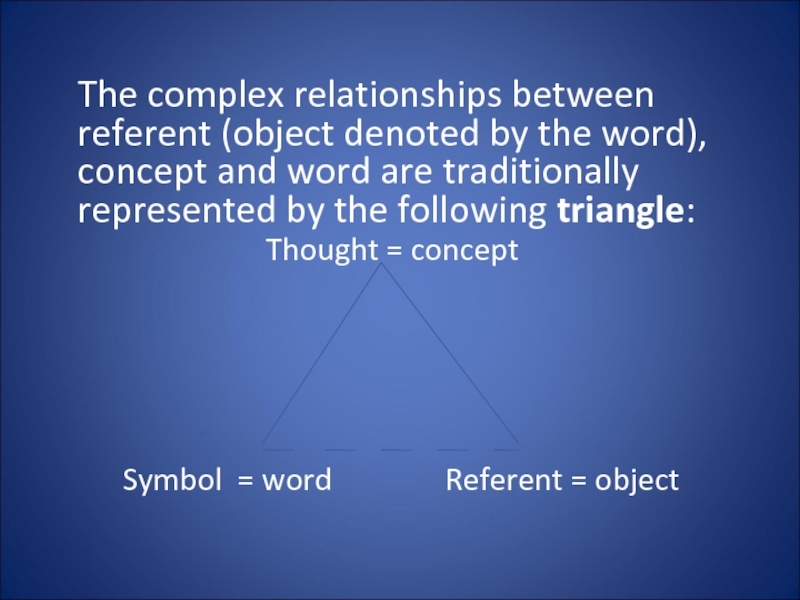
Слайд 19
an animal, with 4
legs and a tail, can bark and
bite
dog
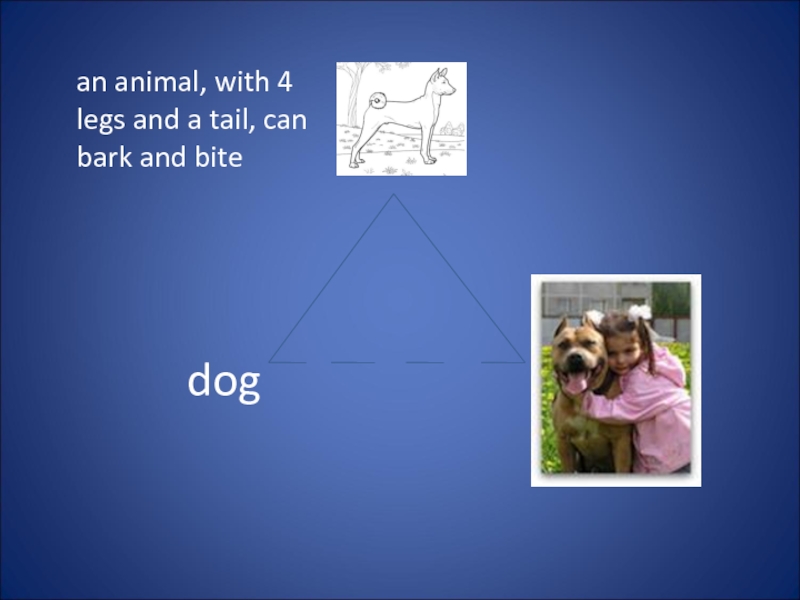
Слайд 20Meaning concept
different words having different meanings may be
used to express the same concept
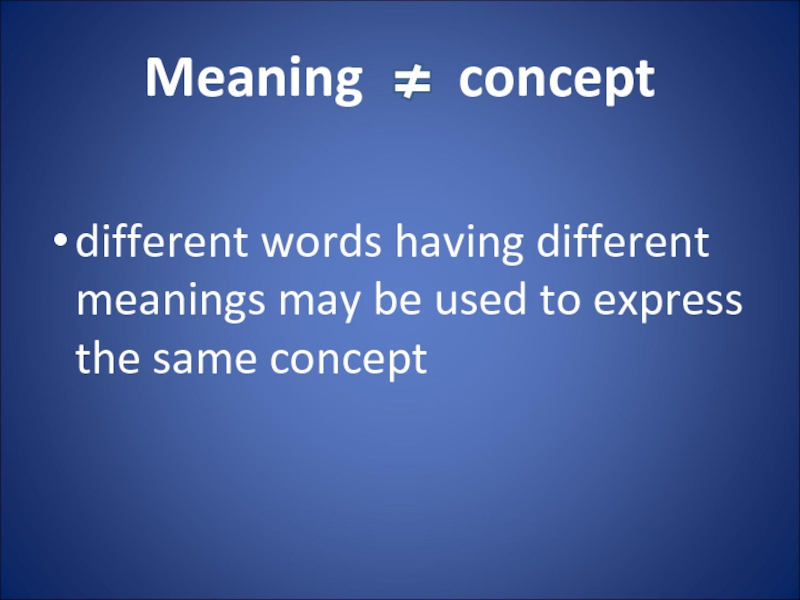
Слайд 21Concept of dying
die
pass away
kick the bucket
join the majority,
etc

Слайд 22Meaning symbol
In different languages:
a word with the same
meaning have different sound forms (dog, собака)
words with the same sound forms have different meaning (лук, look)
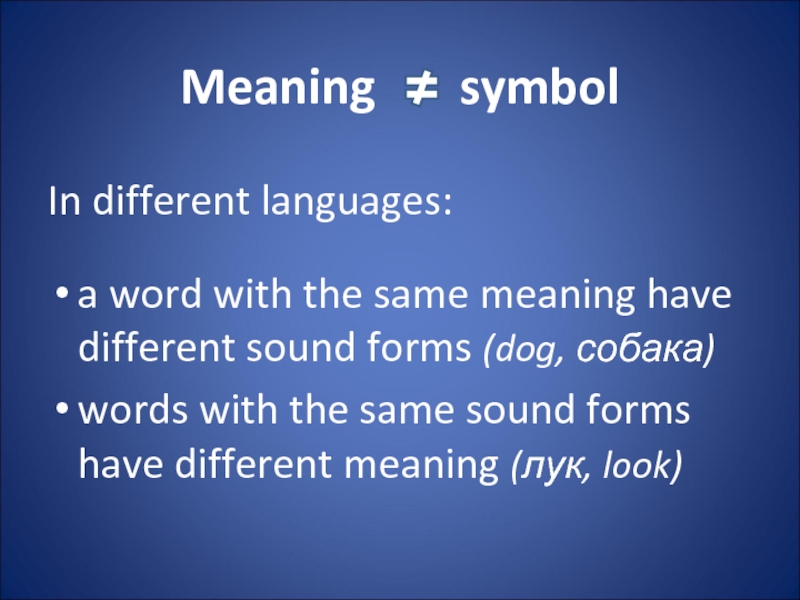
Слайд 23Meaning referent
to denote one and the same object
we can give it different names
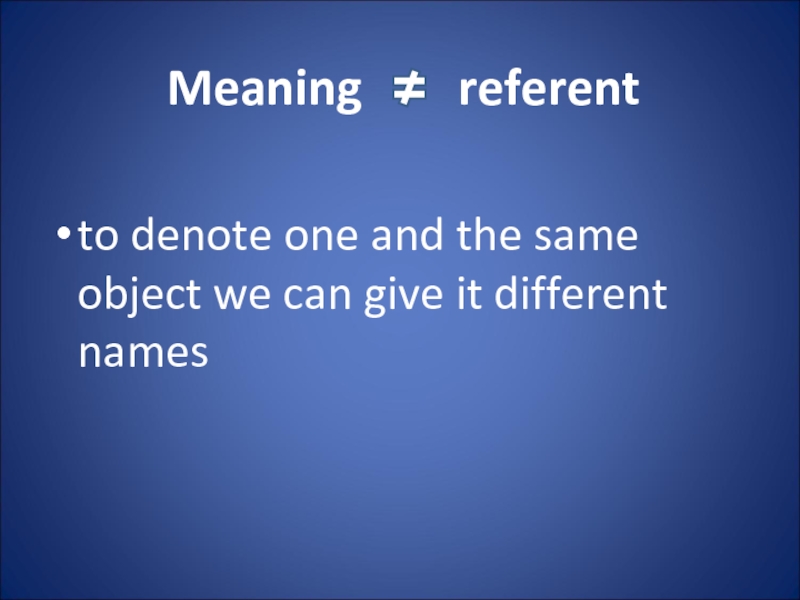
Слайд 24A horse
in various contexts:
horse,
animal,
creature,
it, etc.
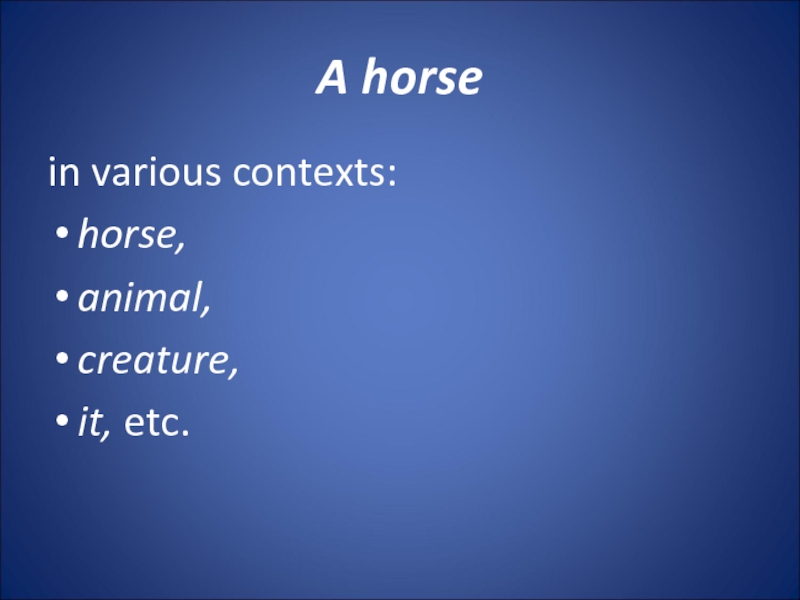
Слайд 25Word meaning:
the interrelation of all three components of
the semantic triangle: symbol, concept and referent, though meaning is not equivalent to any of them.
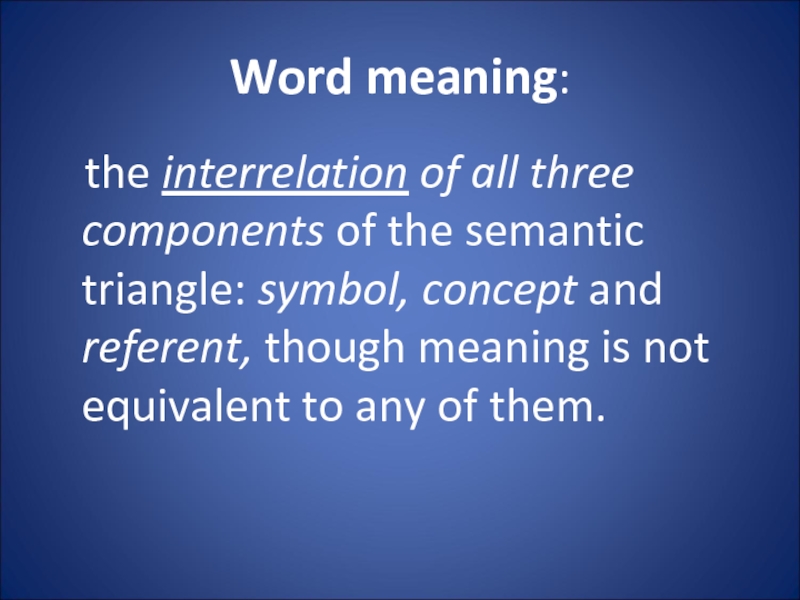
Слайд 26
Functionalists study word meaning by analysis of the way
the word is used in certain contexts.
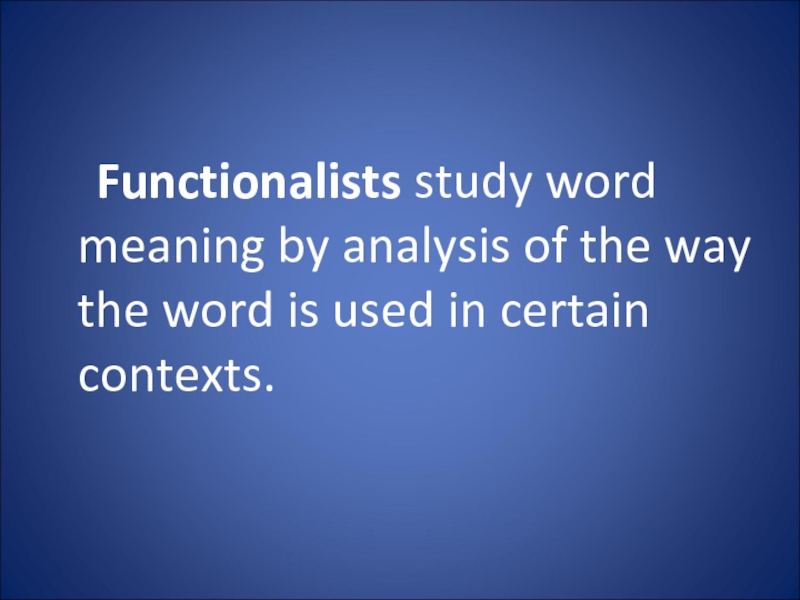
Слайд 27
The meaning of a word is its use
in language.
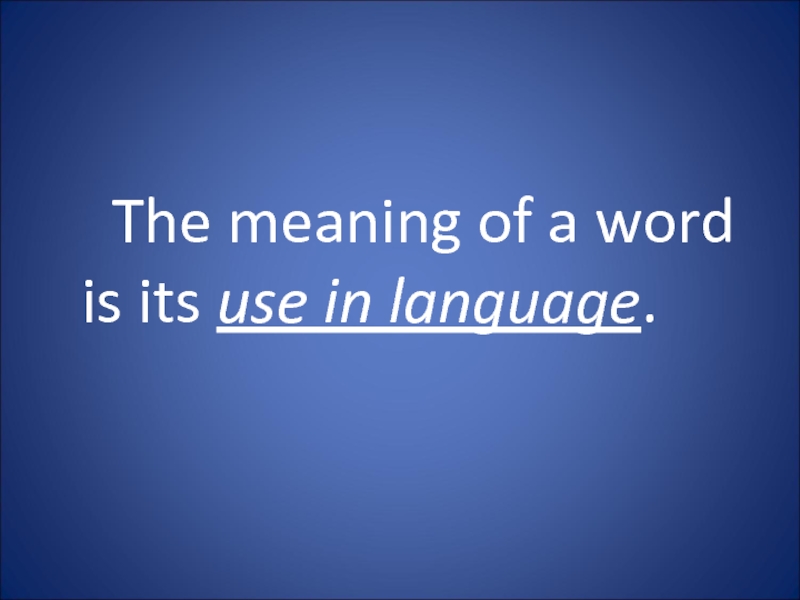
Слайд 28cloud and cloudy
have different meanings because in speech they function
differently and occupy different positions in relation to other words.
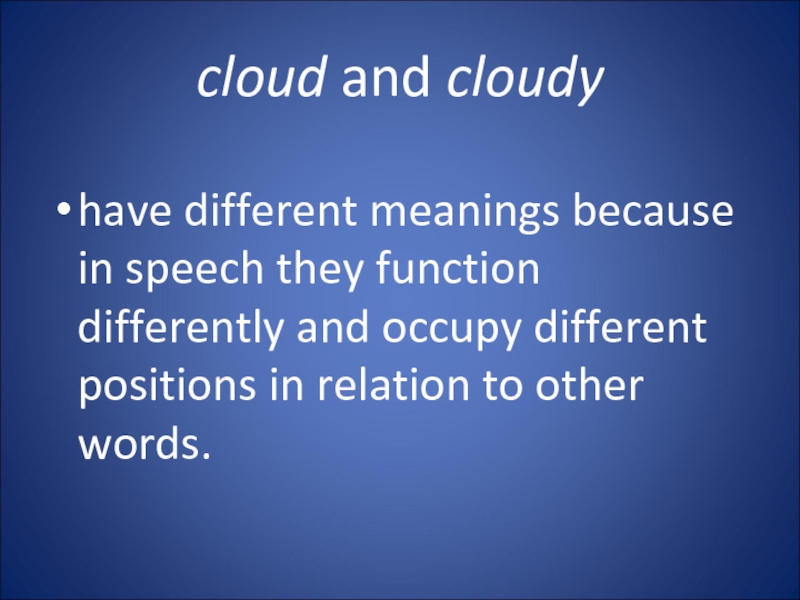
Слайд 29Meaning:
a component of the word through which a concept
is communicated
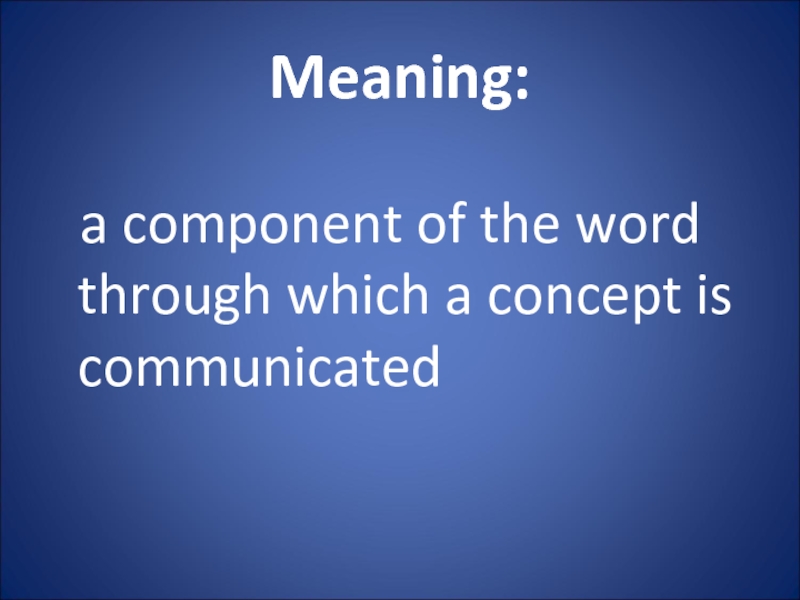
Слайд 31According to the conception of word meaning as a specific structure:
functional
meaning: part of speech meaning (nouns usually denote «thingness», adjectives – qualities and states)
grammatical: found in identical sets of individual forms of different words (she goes/works/reads, etc.)
lexical: the component of meaning proper to the word as a linguistic unit highly individual and recurs in all the forms of a word (the meaning of the verb to work ‘to engage in physical or mental activity’ that is expressed in all its forms: works, work, worked, working, will work)
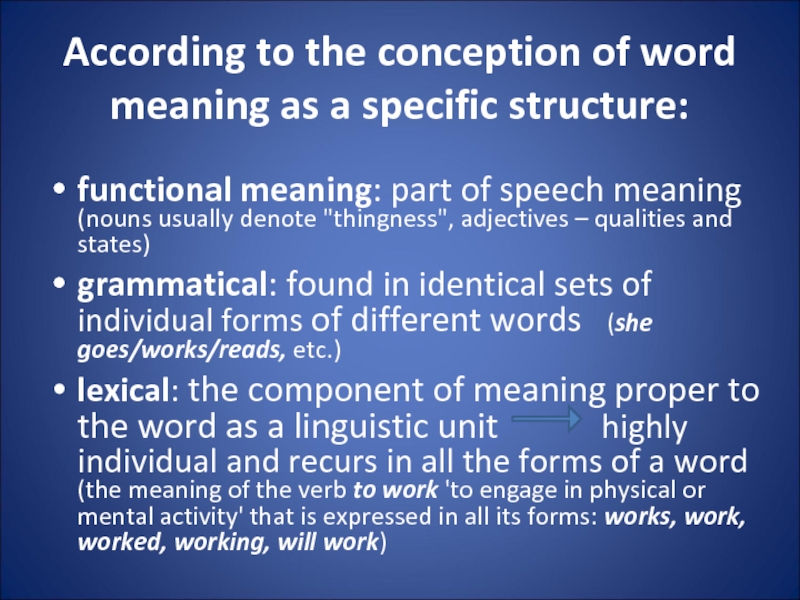
Слайд 32Lexical Meaning:
denotational
connotational
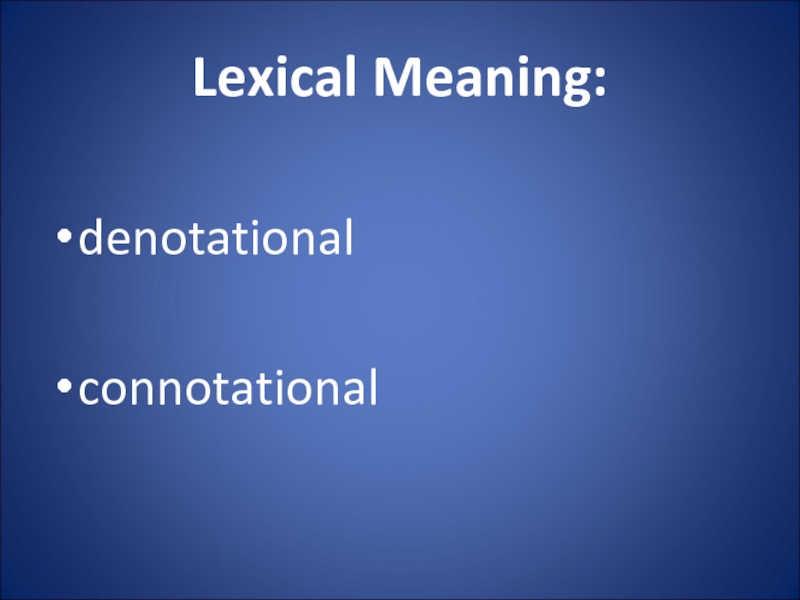
Слайд 33
Denotational lexical meaning provides correct reference of a word to an
individual object or a concept.
It makes communication possible and is explicitly revealed in the dictionary definition (chair ‘a seat for one person typically having four legs and a back’).

Слайд 35
Connotational lexical meaning is an emotional colouring of the
word. Unlike denotational meaning, connotations are optional.
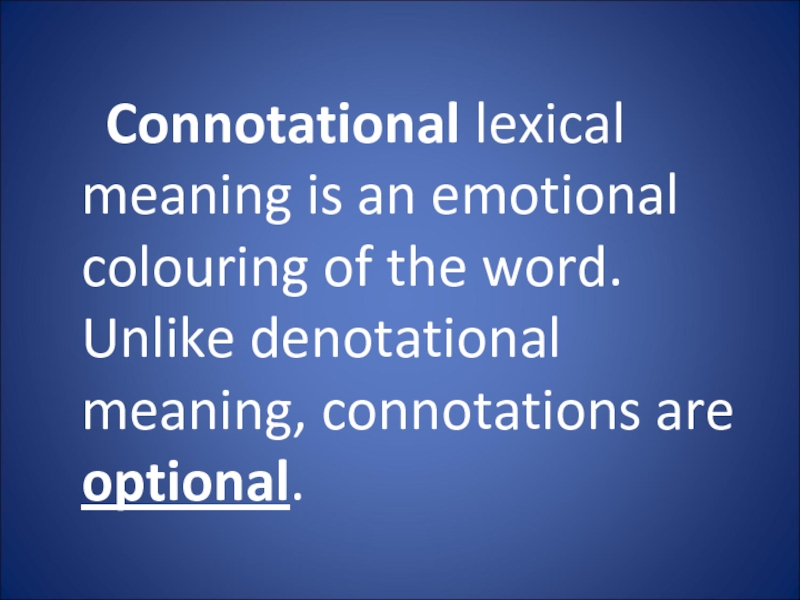
Слайд 36Connotations:
Emotive charge may be inherent in word meaning (like in attractive,
repulsive) or may be created by prefixes and suffixes (like in piggy, useful, useless).
It’s always objective because it doesn’t depend on a person’s perception.
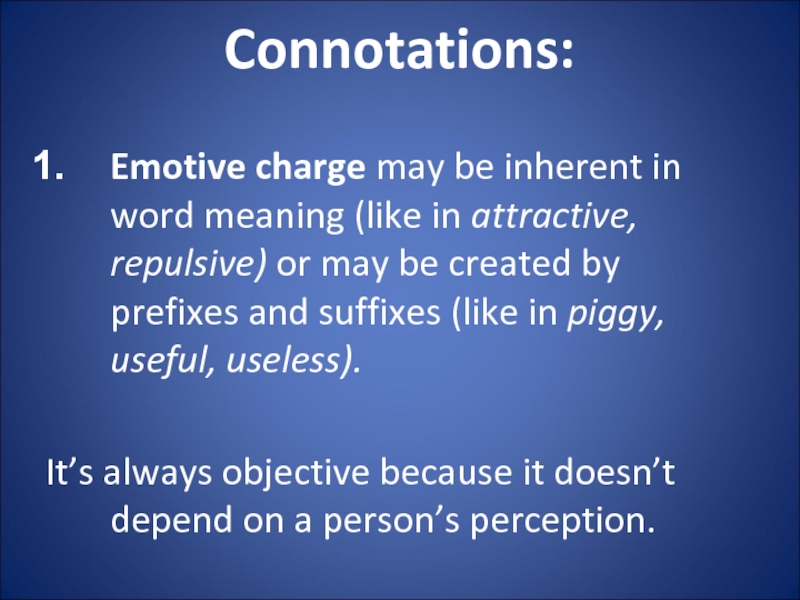
Слайд 37
2. Stylistic reference refers the word to a certain style:
neutral words
colloquial
bookish,
or literary words
Eg. father – dad – parent .
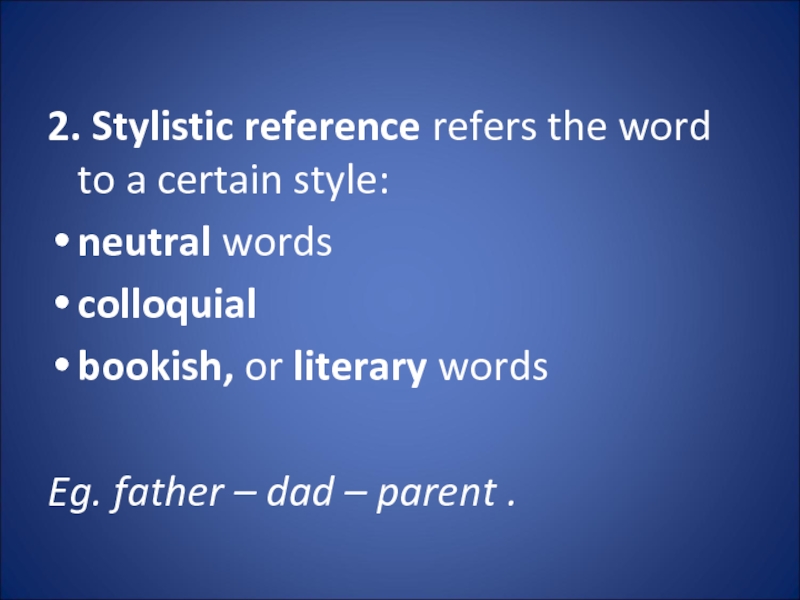
Слайд 38
3. Evaluative connotations express approval or disapproval (charming, disgusting).
4. Intensifying connotations
are expressive and emphatic (magnificent, gorgeous)

Слайд 39
Denotative component
Lonely = alone, without company
To glare = to look
Connotative component
+ melancholy, sad (emotive con.)
+ 1) steadily, lastingly (con. of duration)
+ 2) in anger, rage (emotive con.)
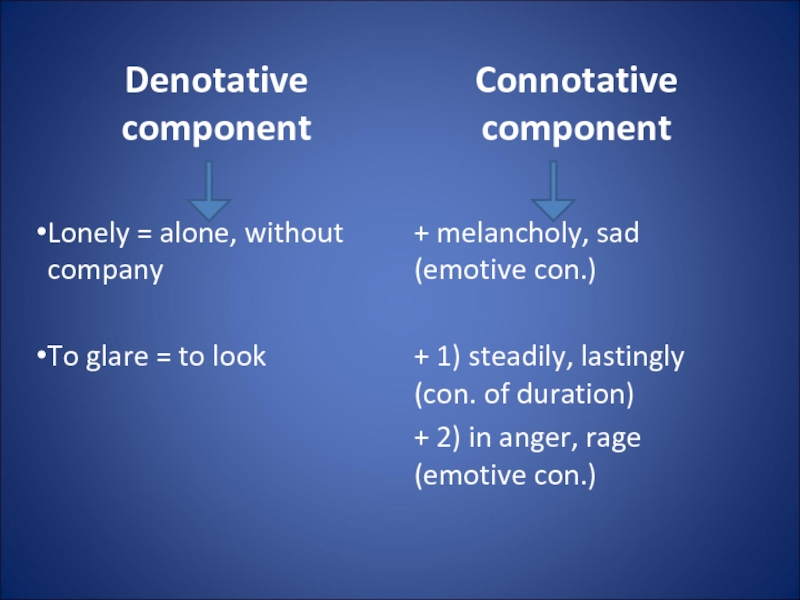
Слайд 40
3. Polysemy. Semantic structure of words. Meaning and context
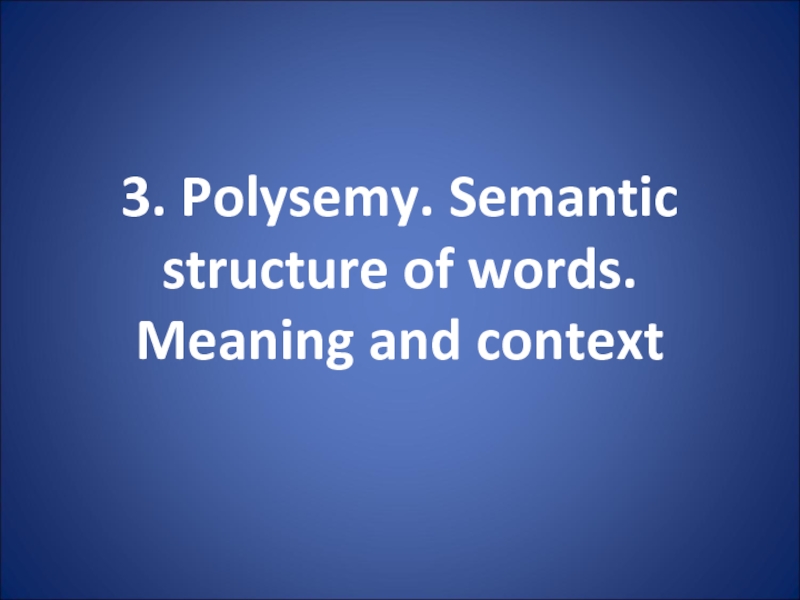
Слайд 41
A polysemantic word is a word having more than one meaning.
Polysemy
is the ability of words to have more than one meaning.
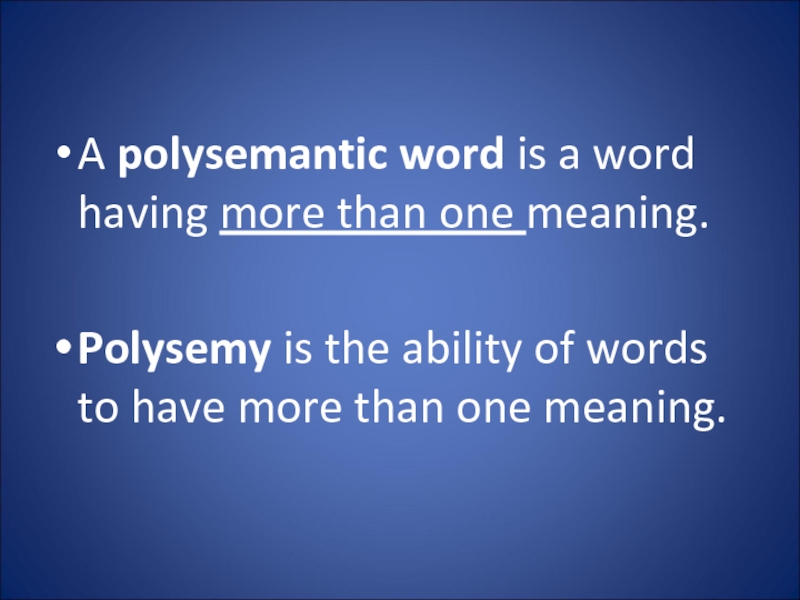
Слайд 42
Most English words are polysemantic.
A well-developed polysemy is a great advantage in a language.
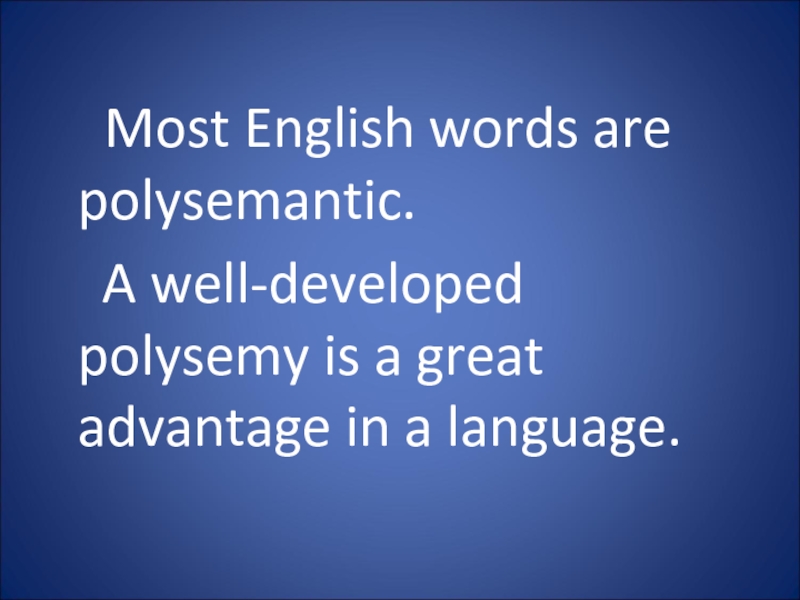
Слайд 43Monosemantic Words:
terms (synonym, bronchitis, molecule),
pronouns (this, my, both),
numerals, etc.
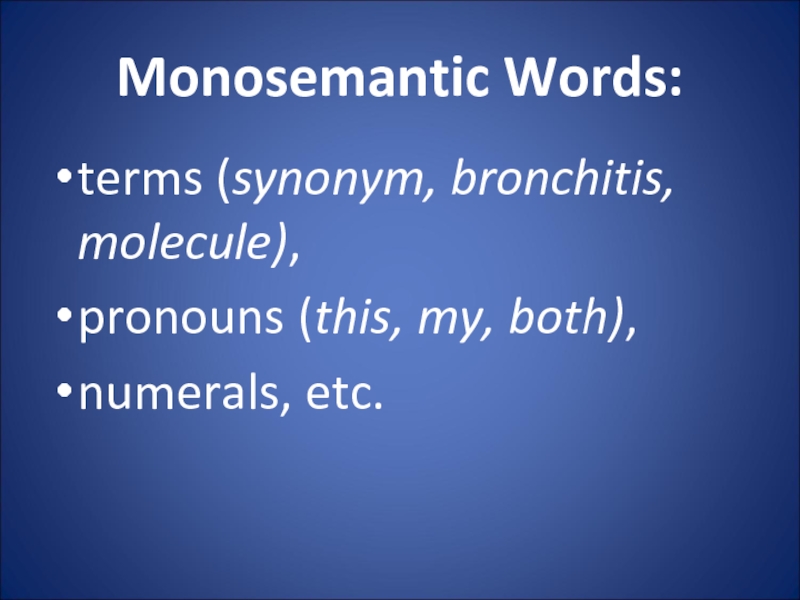
Слайд 44The main causes of polysemy:
a large number of:
1) monosyllabic words;
2) words of long duration (that existed for centuries).
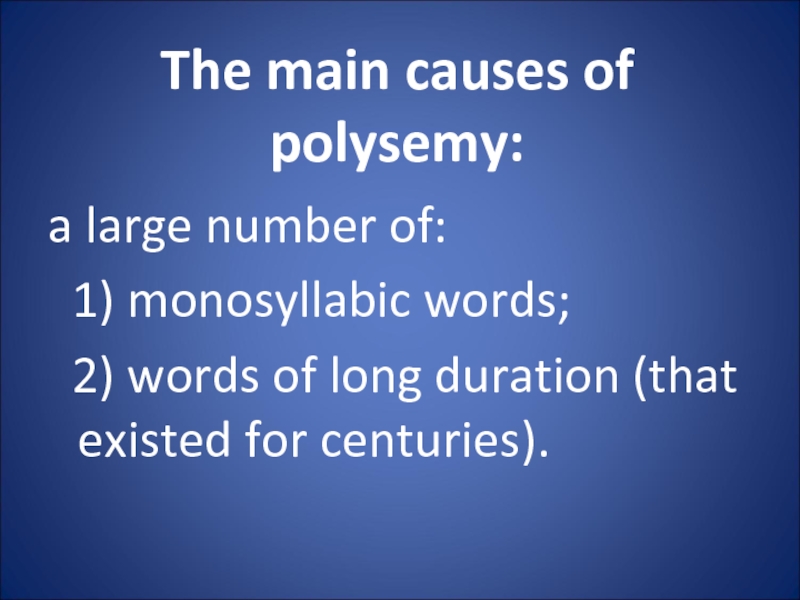
Слайд 45The sources of polysemy:
1) the process of meaning change (meaning specialization:
is used in more concrete spheres);
2) figurative language (metaphor and metonymy);
3) homonymy;
4) borrowing of meanings from other languages.
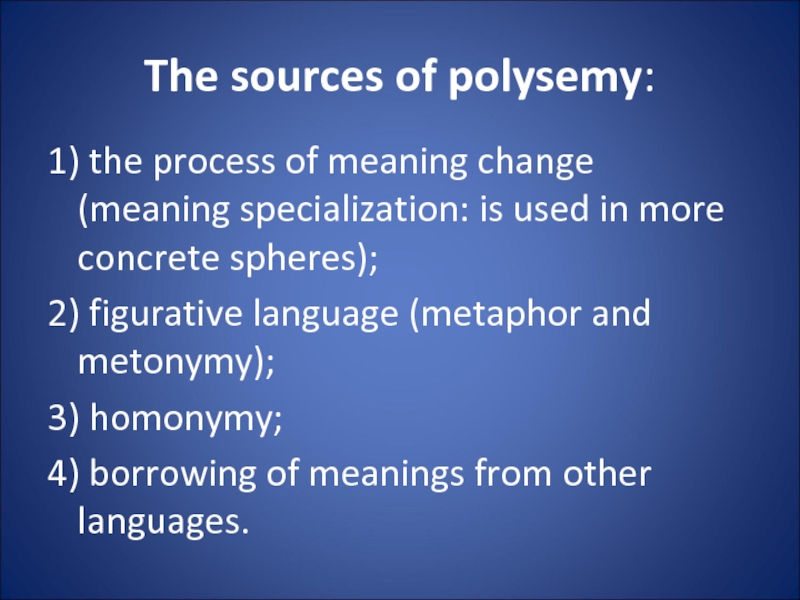
Слайд 46blanket
a woolen covering used on beds,
a covering for keeping a house
warm,
a covering of any kind (a blanket of snow),
covering in most cases (used attributively), e.g. we can say: a blanket insurance policy.
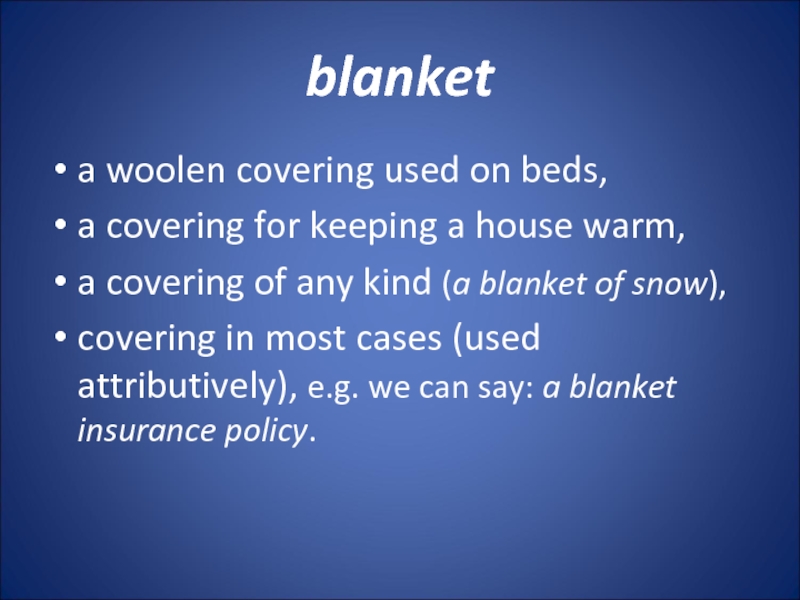
Слайд 47
Meanings of a polysemantic word are organized in a
semantic structure
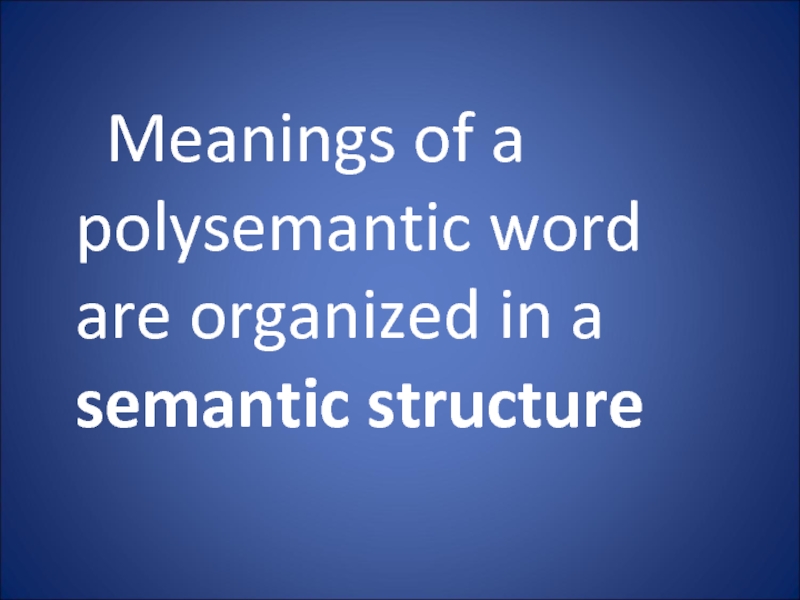
Слайд 48Lexical-semantic variant
one of the meanings of a polysemantic word used
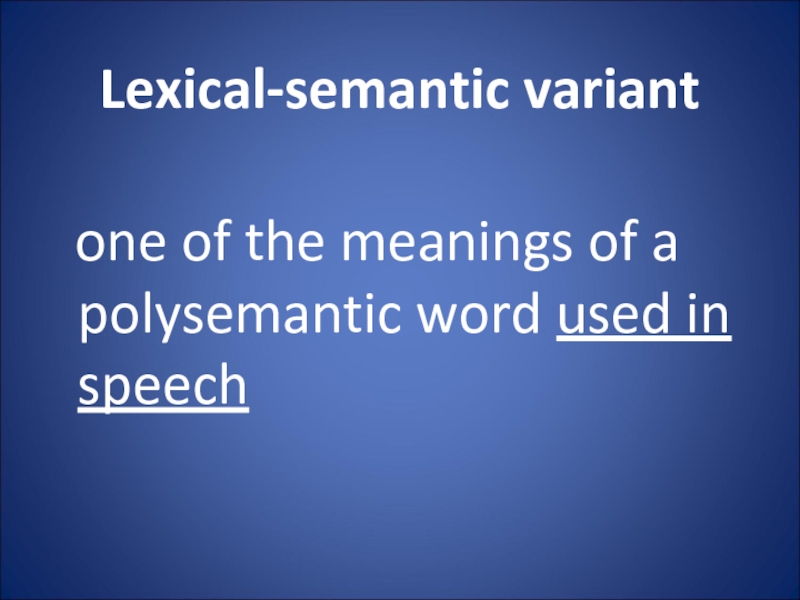
Слайд 49A Word’s Semantic Structure Is Studied:
Diachronically (in the process of its
historical development): the historical development and change of meaning becomes central. Focus: the process of acquiring new meanings.
Synchronically (at a certain period of time): a co-existence of different meanings in the semantic structure of the word at a certain period of language development. Focus: value of each individual meaning and frequency of its occurrence.
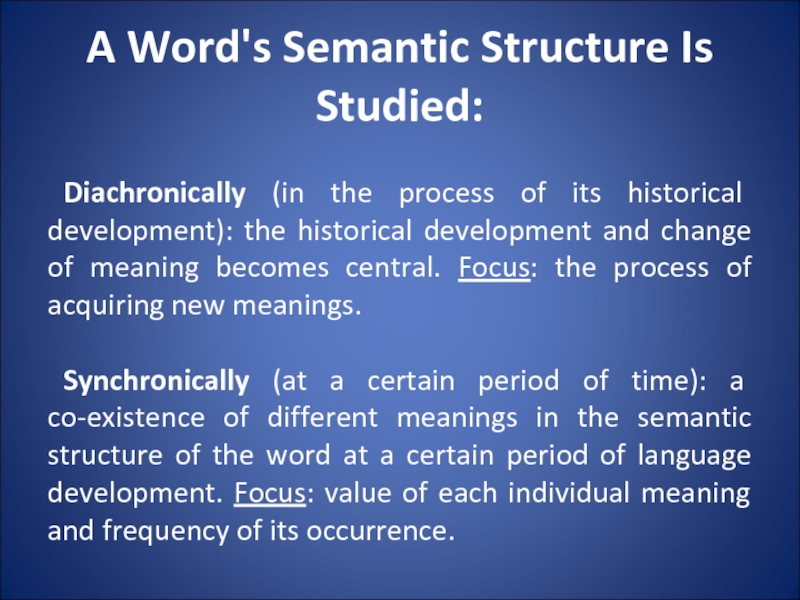
Слайд 50
The meaning first registered in the language is called primary.
Other
meanings are secondary, or derived, and are placed after the primary one.
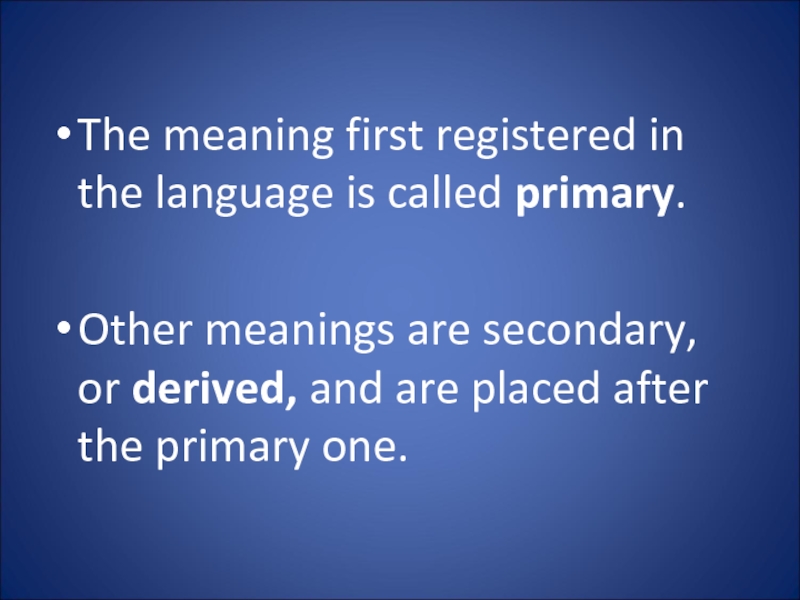
Слайд 51table
a piece of furniture (primary meaning)
the persons
seated at the table
the food put on the table, meals
a thin flat piece of stone, metal, wood
slabs of stone
words cut into them or written on them
an orderly arrangement of facts
part of a machine-tool on which the work is put to be operated on
a level area, a plateau
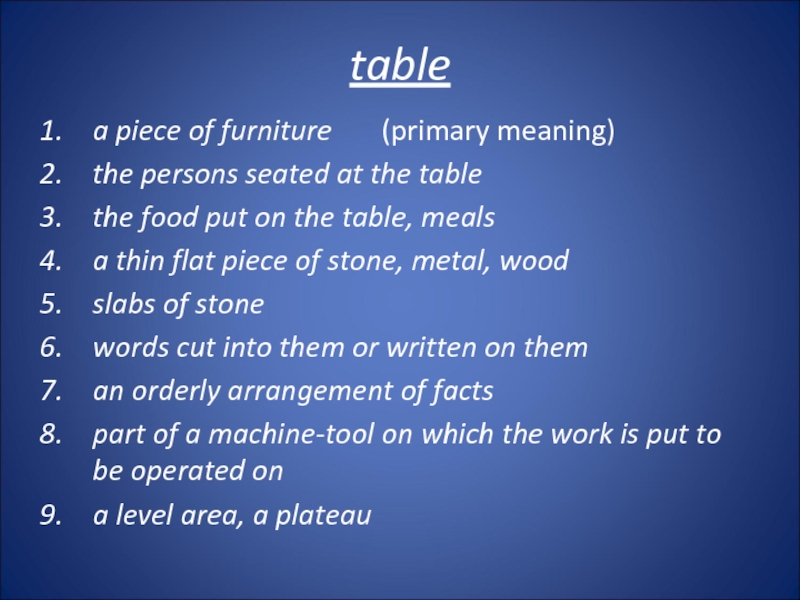
Слайд 52
The meaning that first occurs to our mind, or is understood
without a special context is called the basic or main meaning.
Other meanings are called peripheral or minor.
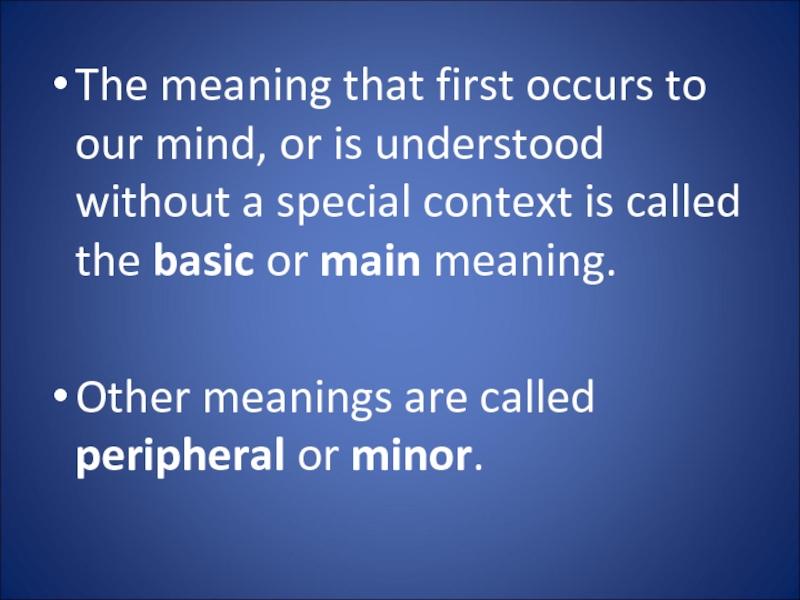
Слайд 53Fire
1. flame (main meaning)
2. an instance of destructive burning
e.g. a forest fire
4. the shooting of guns
e.g. to open fire
3. burning material in a stone, fireplace
e.g. a camp fire
5. strong feeling, passion
e.g. speech lacking fire

Слайд 54Processes of the Semantic Development of a Word:
radiation (the primary meaning
stands in the center and the secondary meanings proceed out of it like rays. Each secondary meaning can be traced to the primary meaning)
concatenation (secondary meanings of a word develop like a chain. It is difficult to trace some meanings to the primary one)
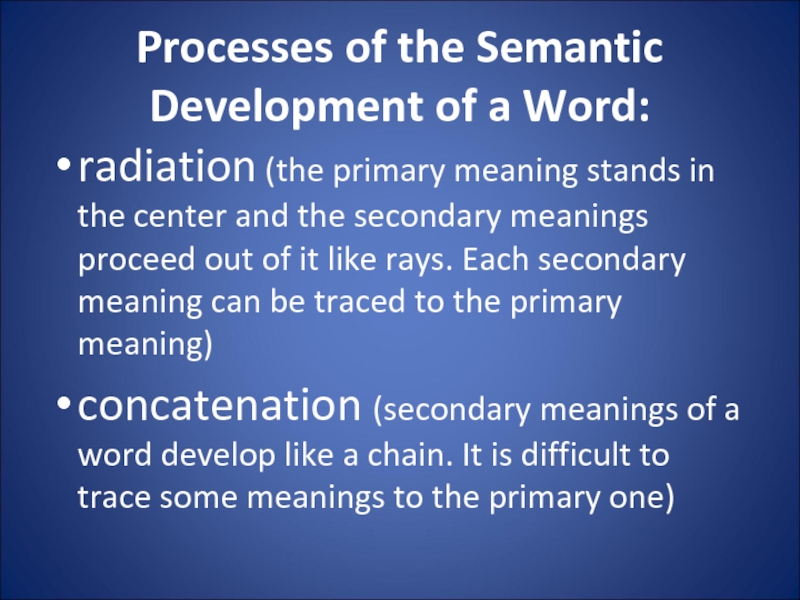
Слайд 55crust
hard outer part of bread
hard part of anything (a
pie, a cake)
harder layer over soft snow
a sullen gloomy person
Impudence
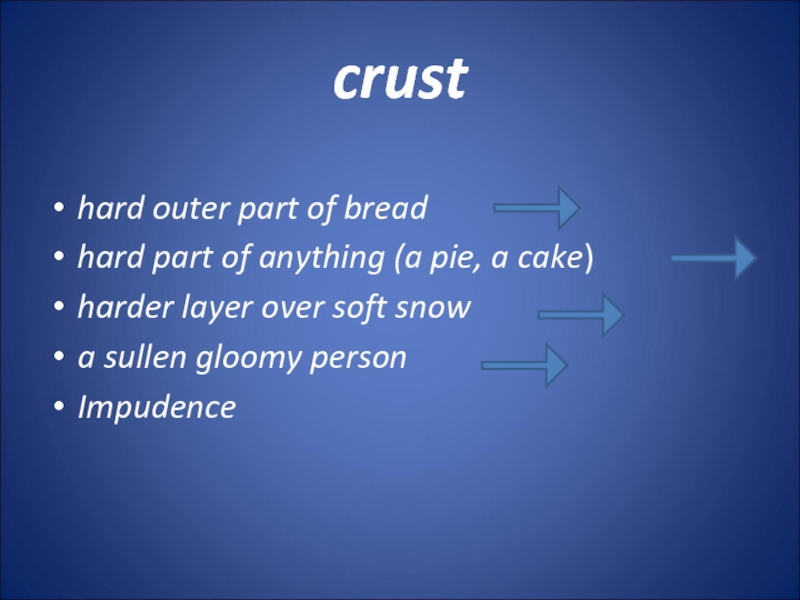
Слайд 56
Polysemy exists not in speech but in the language.
It’s
easy to identify the main meaning of a separate word. Other meanings are revealed in context.
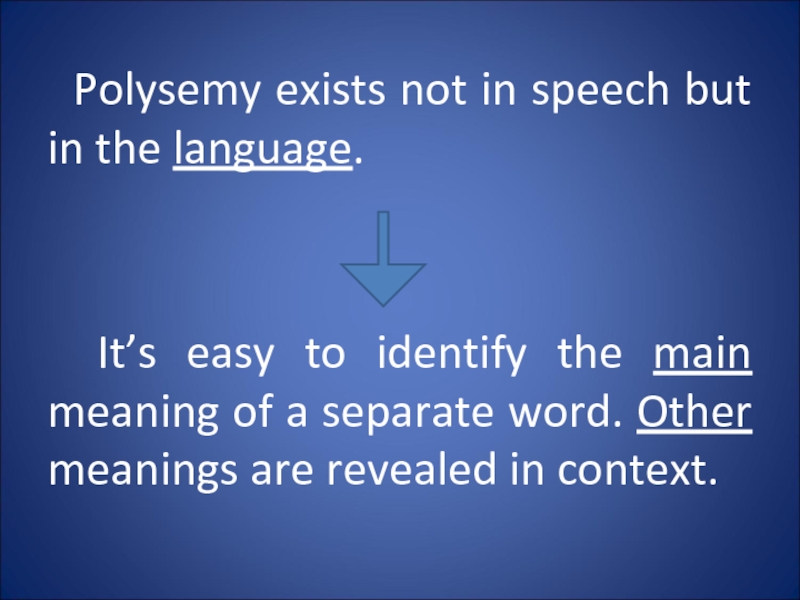
Слайд 57Context:
linguistic
1. lexical – a number of lexical units
around the word which enter into interaction with it (i.e. words combined with a polysemantic word are important).
2. grammatical – a number of lexical units around the world viewed on the level of parts of speech.
3. thematic – a very broad context, sometimes a text or even a book.
extralinguistic – different cultural, social, historical factors
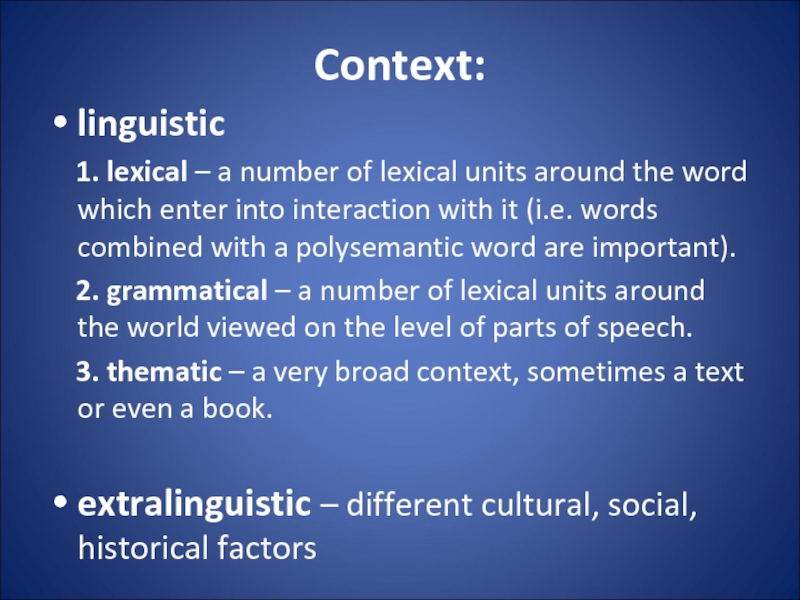
Слайд 58
4. Change of word-meaning: the causes, nature and results
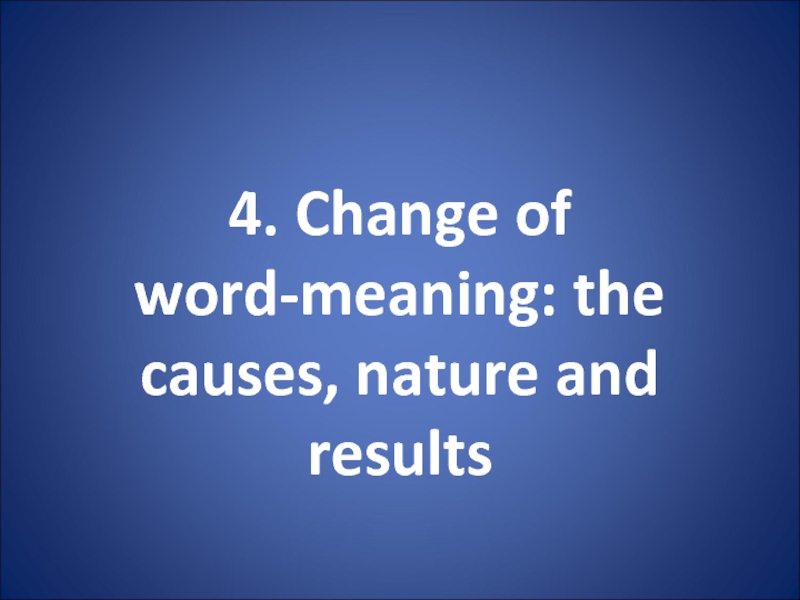
Слайд 59
The meaning of a word can change in a course
of time.
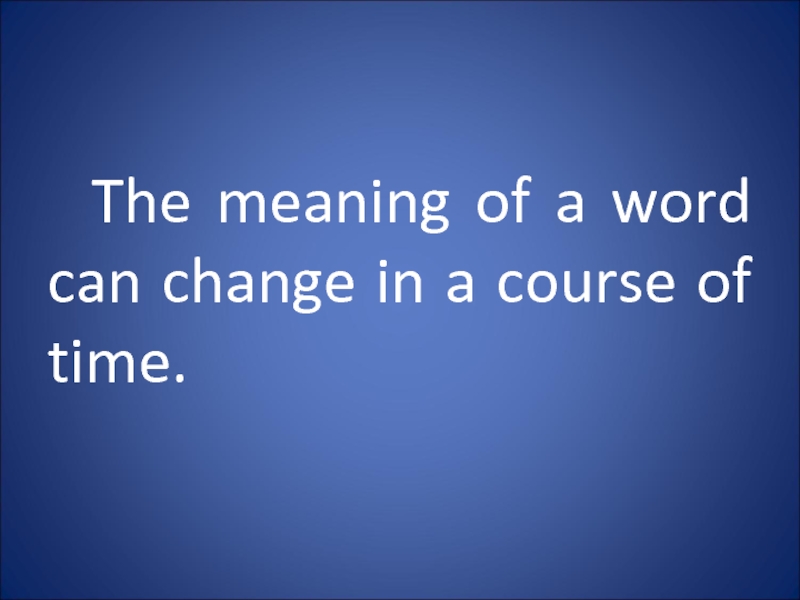
Слайд 60Causes of Change of
Word-meaning:
1. Extralinguistic (various changes in the life
of a speech community, in economic and social structure, in ideas, scientific concepts)
e.g. “car” meant ‘a four-wheeled wagon’; now – ‘a motor-car’, ‘a railway carriage’ (in the USA)
“paper” is not connected anymore with “papyrus” – the plant from which it formerly was made.
2. Linguistic (factors acting within the language system)
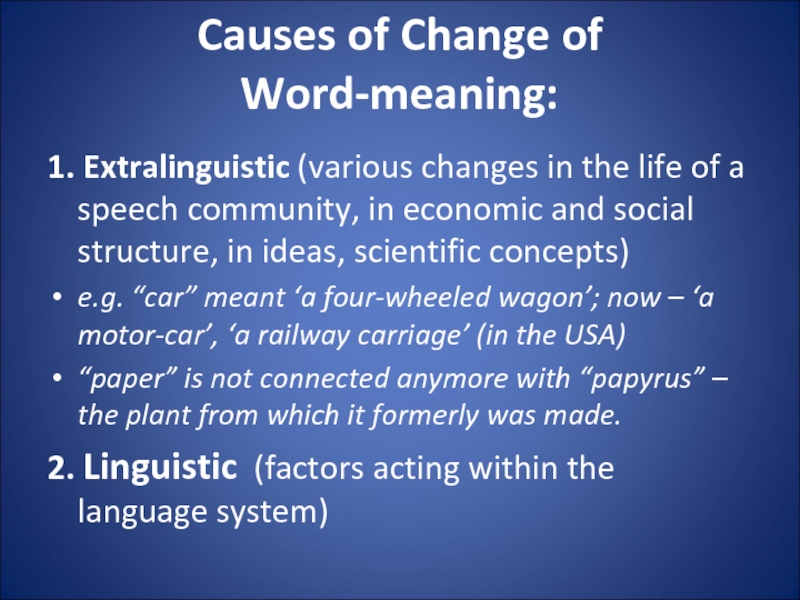
Слайд 61Linguistic Causes:
1. ellipsis – in a phrase made up of two
words one of these is omitted and its meaning is transferred to its partner.
e.g. “to starve” in O.E. = ‘to die’ + the word “hunger”. In the 16th c. “to starve” = ‘to die of hunger’.
e.g. daily = daily newspaper
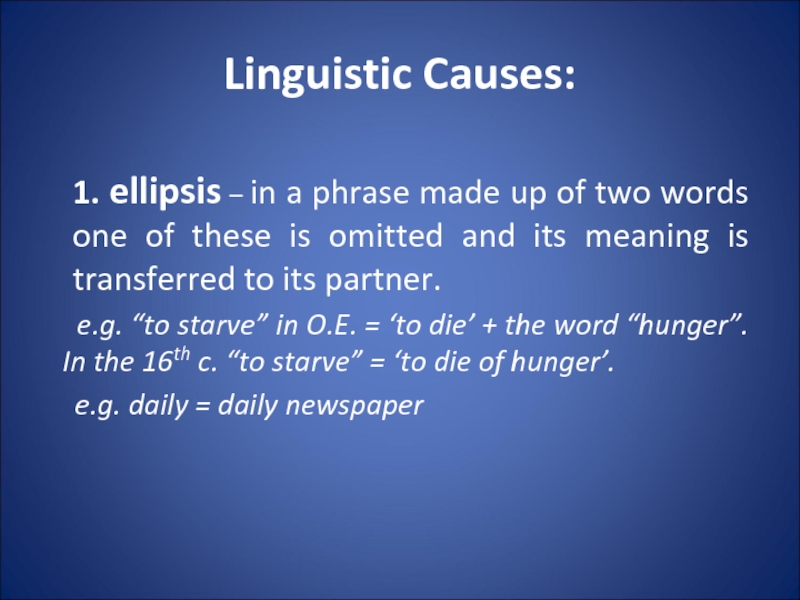
Слайд 62Linguistic Causes:
2. differentiation (discrimination) of synonyms – when a new
word is borrowed it may become a perfect synonym for the existing one. They have to be differentiated; otherwise one of them will die.
e.g. “land” in O.E. = both ‘solid part of earth’s surface’ and ‘the territory of the nation’. In the middle E. period the word “country” was borrowed as its synonym; ‘the territory of a nation’ came to be denoted mainly by “country”.
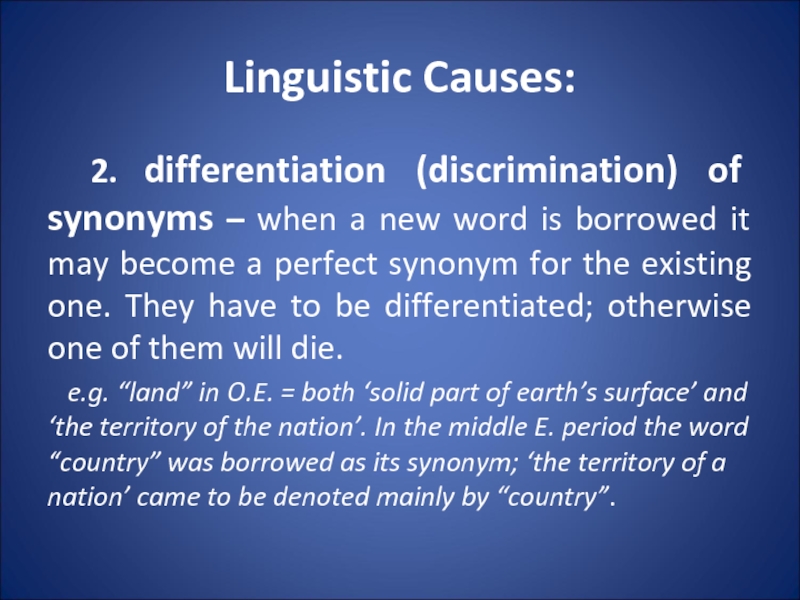
Слайд 63Linguistic Causes:
3. linguistic analogy – if one of the members of
the synonymic set acquires a new meaning, other members of this set change their meaning too.
e.g. “to catch” acquired the meaning ‘to understand’; its synonyms “to grasp” and “to get” acquired this meaning too.

Слайд 64
The nature of semantic changes is based on the
secondary application of the word form to name a different yet related concept.
Conditions to any semantic change: some connection between the old meaning and the new.
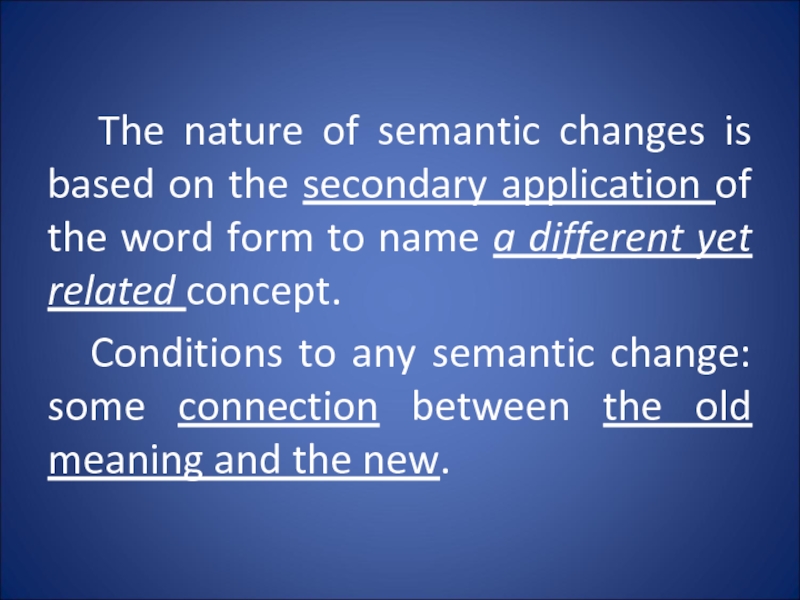
Слайд 65Association between Old Meaning and New:
similarity of meanings or metaphor –
a semantic process of associating two referents one of which in some way resembles the other
contiguity (closeness) of meanings or metonymy – a semantic process of associating two referents one of which makes part of the other or is closely connected with it
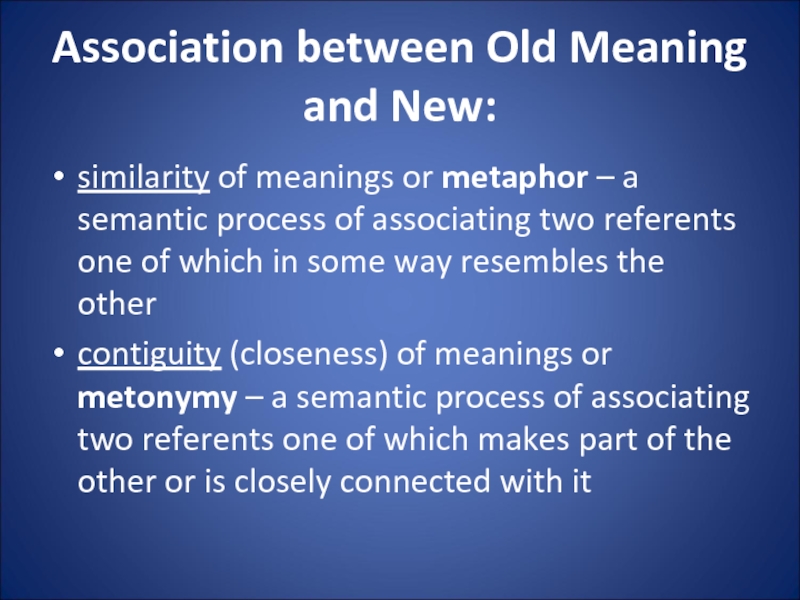
Слайд 66Types of Metaphor:
a) similarity of shape, e.g. head (of a cabbage),
bottleneck, teeth (of a saw, a comb);
b) similarity of position, e.g. foot (of a page, of a mountain), head (of a procession);
c) similarity of function, behavior, e.g. a bookworm (a person who is fond of books);
d) similarity of color, e.g. orange, hazel, chestnut.
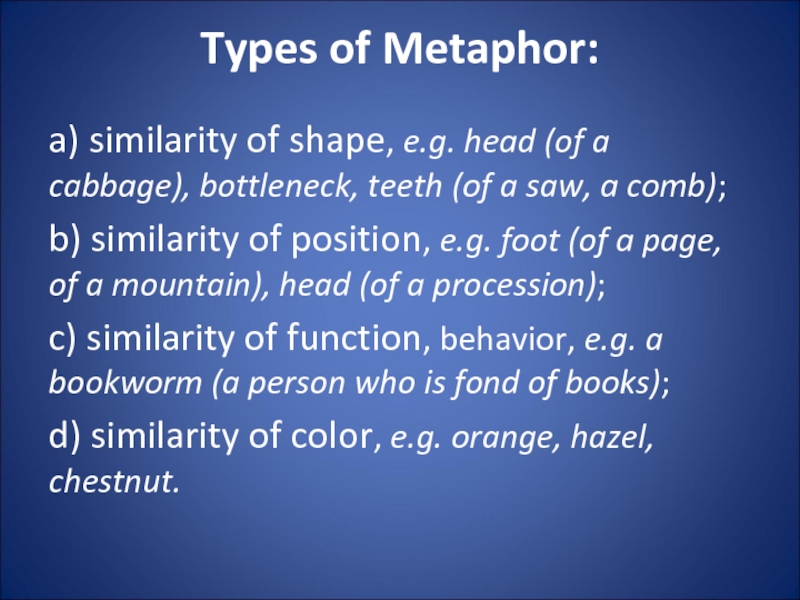
Слайд 67Types of Metonymy:
‘material — object of it’ (She is wearing a
fox);
‘container — containее’ (I ate three plates);
‘place — people’ (The city is asleep);
‘object — a unit of measure’ (This horse came one neck ahead);
‘producer — product’ (We bought a Picasso);
‘whole — part’ (We have 10 heads here);
‘count — mass’ (We ate rabbit)
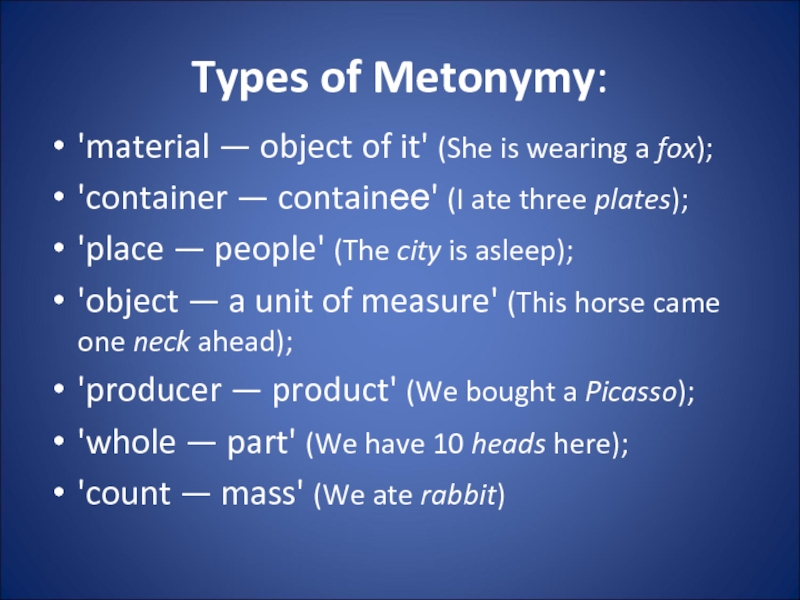
Слайд 68Results of Semantic Change:
changes in the denotational component
changes in the connotational
meaning
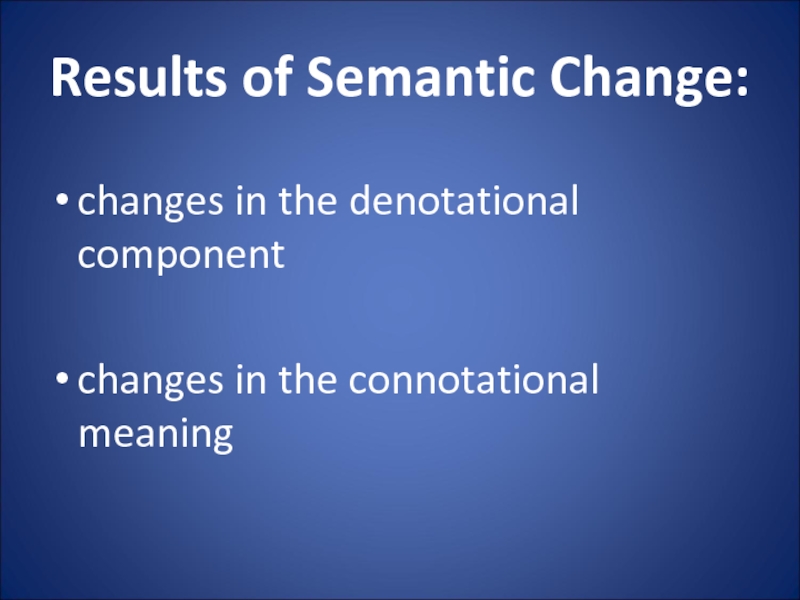
Слайд 69Changes in the Denotational Component:
restriction – a word denotes a restricted
number of referents.
e.g. “fowl” in O.E. = ‘any bird’, but now ‘a domestic hen or chicken’
extension – the application of the word to a wider variety of referents
e.g. ‘‘a cook’’ was not applied to women until the 16th century.
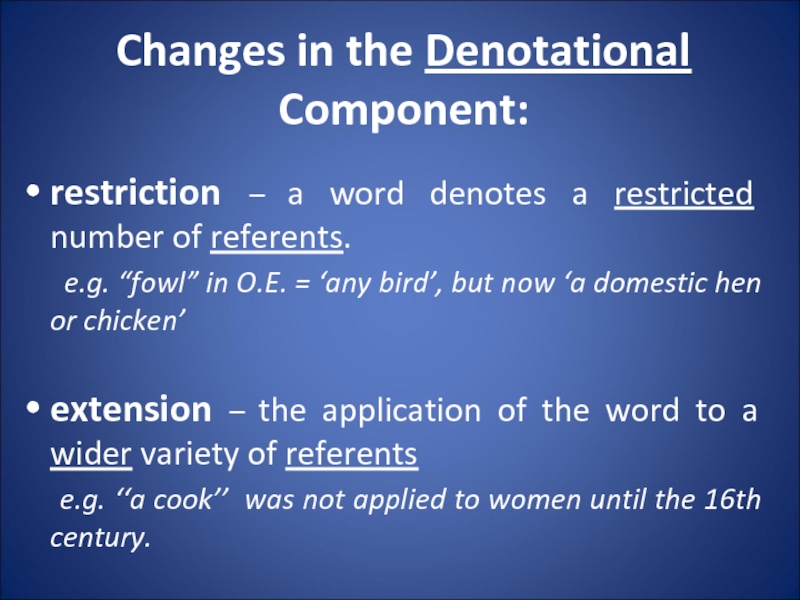
Слайд 70
generalization – the word with the extended meaning passes from the
specialized vocabulary into common use and the meaning becomes more general.
e.g. “camp” = ‘the place where troops are lodged in tents’; now – ‘temporary quarters’.
specialization – the word with the new meaning comes to be used in the specialized vocabulary of some limited group.
e.g. “to glide” = ‘to move gently and smoothly’ and now has acquired a special meaning – ‘to fly with no engine’.
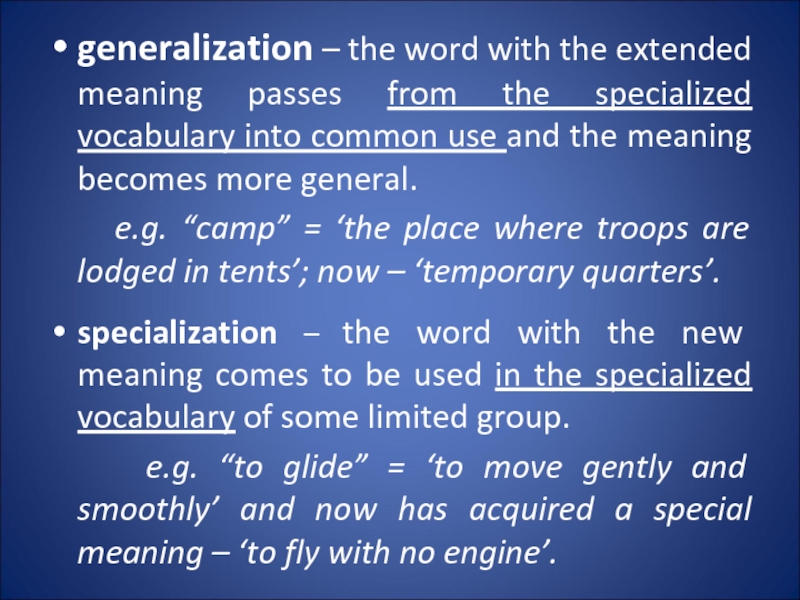
Слайд 71Changes in the Connotational Meaning:
pejorative development (degradation) – the acquisition by
the word of some derogatory emotive charge.
e.g. “accident” ‘a happening causing loss or injury’ came from more neutral ‘something that happened’;
ameliorative development (elevation) – the improvement of the connotational component of meaning.
e.g. “a minister” denoted a servant, now – ‘a civil servant of higher rank, a person administering a department of state’
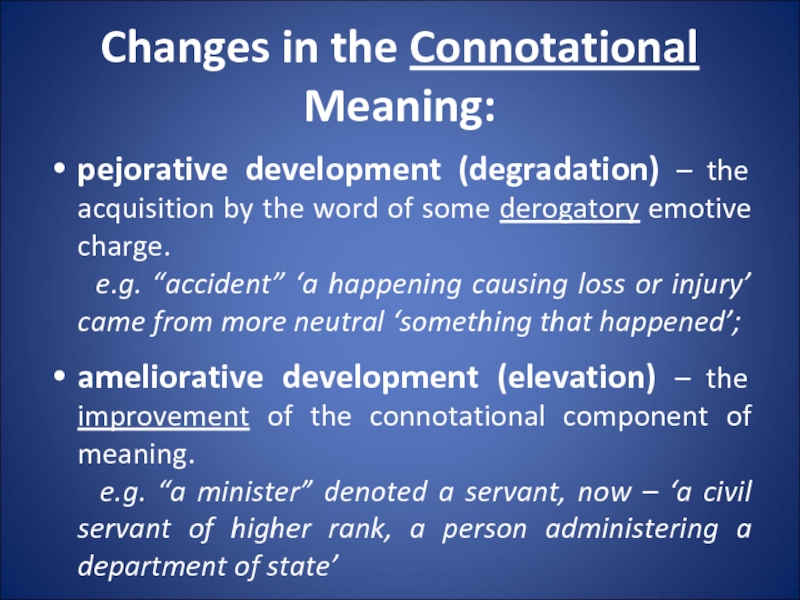
Слайд 72List of Literature:
Антрушина, Г. Б. Лексикология английского языка: учебник для студ.
пед. ин-тов по спец. № 2103 «Иностр. яз.» / Г. Б. Антрушина, О. В. Афанасьева, Н. Н. Морозова; под ред. Г. Б. Антрушиной. – М.: Высш. школа, 1985. – С. 129–142, 147–160.
Воробей, А. Н. Глоссарий лингвистических терминов / А. Н. Воробей, Е. Г. Карапетова. – Барановичи: УО «БарГУ», 2004. – 108 с.
Дубенец, Э. М. Современный английский язык. Лексикология: пособие для студ. гуманит. вузов / Э. М. Дубенец. – М. / СПб.: ГЛОССА / КАРО, 2004. – С. 74–82, 123–127.
Лексикология английского языка: учебник для ин-тов и фак-тов иностр. яз. / Р. З. Гинзбург [и др.]; под общ. ред. Р. З. Гинзбург. – 2-е изд., испр. и доп. – М.: Высш. школа, 1979. – С. 13–23, 28–39, 47–51.
Лещева, Л. М. Слова в английском языке. Курс лексикологии современного английского языка: учебник для студ. фак-в и отдел. английского языка (на англ. яз.) / Л. М. Лещева. – Минск: Академия управления при Президенте Республики Беларусь, 2001. – С. 36–56.
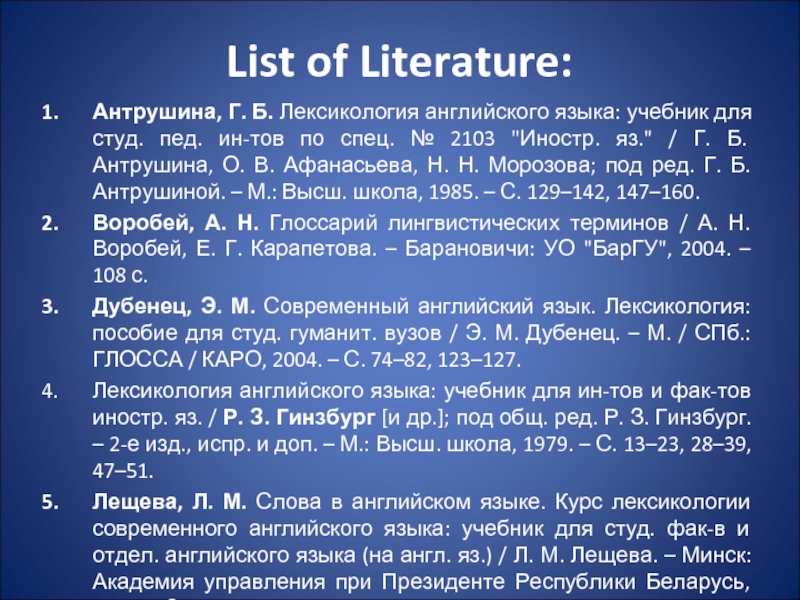
In this work multiple senses of lexical items will be analyzed. We will see how the meaning of the lexical item can be differ when it stands by itself and when it is used in context with a different word. English language is known for its variety of words and their use. So, we will observe how particular English words may vary in different contexts. Primary, secondary and idiomatic senses will be discussed in this work as well as the ambiguity caused by senses in the translation.
Key words: primary meaning, secondary meaning, idiomatic meaning, ambiguity.
Primary sense is the core, basic, literal meaning of a lexeme. A primary sense is generally the first meaning that comes to mind for most people when a lexeme is uttered alone. Usually it refers to an actual physical thing, an action, or a characteristic of a referent. (http://www.glossary.sil.org/term/primary-sense)
The primary sense is the meaning suggested by the word when it is used alone. It is the first meaning or usage which a word will suggest to most people when the word is said in isolation. It is the meaning learned early in life and is likely to have reference to a physical situation. But the same word may have a different meaning when used in context with other words. (Larson, M, L. (2012) “Meaning Based Translation” University Press of America. New York, 589 p.)
A secondary sense is a meaning that is more abstract than a primary sense of a lexeme but still shares some of its semantic components. Because it has a different range of reference, its usage contexts and collocates are different from those of a primary sense. For example, let’s take the word «make» in English. The primary meaning of make is to do something for example «She makes dinner”. The secondary meaning is to tuck something for example “She makes her bed every morning». Here the word «make» doesn’t mean that somebody is actually doing the bed, it means that she tucks the sheets and pillows.
Secondary Meaning or Secondary Sense.
A speaker of Russian will say that «язык» means the language, but the Russian speaker will also tell you that «язык» means:
– В мире существуют более 10 000 языков. (There are more than 10 000 languages in the world).
– Язык является мышечным органом во рту большинства позвоночных, который манипулирует пищей для жевания. (The tongue is a muscular organ in the mouth of most vertebrates that manipulates food for mastication).
– Язык колокола после удара должен мгновенно отскочить от звукового пояса, ане «прилипать» кнему. (The clapper after the shot should bounce off the sonic zone and not «stick» to it).
– ЯзыкПушкинапредставляетразительныепримерысемантическоймногоплановостислова (Pushkin’s language presents striking examples of semantic diversity of the word).
Translating the primary sense of a lexical item is usually much easier than a secondary sense. This is because the receptor language will often have a lexical equivalent for the primary meaning which very nearly matches the meaning of the lexical item in the source language. However, the secondary senses of those same two words will probably not match. (Larson, 2012: 113) A native speaker knows immediately by the other words which occur in the phrase or sentence which sense of the word is being signaled. Learners of a second language often have a great deal of trouble to use a word in its many secondary senses.
|
English |
Russian |
|
He called her name to see if she was home. |
Он позвал её имя, чтобы посмотреть дома ли она. |
|
Will you call the family to dinner? |
Ты пригласишь свою семью на ужин? |
|
She called her parents yesterday. |
Она позвонила своим родителям вчера. |
Any word used in a non-primary sense will probably not be translated by
the word in the receptor language which is equivalent to its primary sense, but
by a different word. For example, the primary sense of key would be translated
into Turkish with “anahtar.” But notice the following list which shows how they differ in translating secondary senses:
|
English |
Russian |
|
A sheet |
Листок (бумаги) |
|
A sheet |
Простынь |
|
A sheet |
Парус |
|
English |
Russian |
|
Лист |
A Leaf |
|
Лист |
A sheet |
|
Лист |
Baking tray |
Analyzing senses of words.
The process for discovering the various senses of words is rather complicated but can be very crucial for making dictionaries, learning a second language, and may also be helpful to the translator when no dictionaries are available which give an adequate description of the senses of words in the language. (Beekman and Callow: 1974) A translator who is truly bilingual in the source and receptor languages will usually recognize a non-primary sense.
Nevertheless, there is always the possibility that a literal translation of a word may be used in a secondary sense. This literal translation sets up a strange collocation and wrong meaning (Larson, 2012: 113)
Step 1. Collecting data.
One must first collect as many examples of the use of the word as possible. If a person knows the language he can simply think of all the possible combinations with other words. If not, he will need to find the word in as many texts as possible. A concordance done on the computer will greatly speed up the search, learning a language, or hoping to make a dictionary, will want to begin early in his research to collect data on each word of the language, building up more words and more examples of their co-occurrence with other words. The goal is to list as many collocate as possible. For our purposes, we shall now assume that we have found the following (Beekman and Callow 1974, chapter 11)
|
– They go to supermarket every day. |
– Они ходят всупермаркет каждый день. |
|
– They always go by bus. |
– Они всегда ездят на автобусе. |
|
– People come and go all the time. |
– Люди приходят и уходят все время. |
|
– She goes mad when something is wrong. |
– Она сходит с ума, когда что-то идет не так. |
|
– She always goes barefoot |
– Она всегда ходит босиком |
|
– We go to sleep at 9 o’clock |
– Мы ложимся спать в 9 часов |
|
– I will go 50 dollars per ticket, but no more |
– Я заплачу только 50 долларов и не больше |
|
– I could go abig steak right now |
– Я бы сейчас съел большой стейк. |
|
– A man with alot of go |
– Человек с большой энергией. |
|
– Thirty dollars? It’s ago! |
– Тридцать долларов? Сделка! |
|
– The boss gave us ago on our new project. |
– Босс дал свое разрешение по поводу нашего нового проекта |
|
– He goes into debt once in two months. |
– Он залезает в долги один раз в три месяца. |
|
– I can’t go his preaching. |
– Я не могу выносить его исповедания. |
Step 2. Sort the collocates into generic classes.
Each grammatical form should be analyzed separately. In this example, we
have used only intransitive verb forms. If the noun run occurred, this noun form would need to be separated and analyzed separately. One begins by making best guesses, refining the analysis as he goes.
– Movement or proceeding (go by bus, by train, got to amarket)
– To become as specified (go mad)
– to act so as to come into acertain state or condition: (to sleep, go into debt)
– to risk, pay, afford, bet, or bid: (go fifty dollars)
– Appreciate, desire, want (go abig steak)
– Energy spirit (a man with alot of go)
– Approval or permission (boss gave ago)
Step 3. Regroup the contexts according to the collocates which belong to the same generic classes as follows.
– Money and documents
– I will go 50 dollars per ticket, but no more
– The boss gave us a go on our new project.
– Thirty dollars? It’s a go!
– Moving or proceeding
- They always go by bus
- They always go to the market.
– Condition
- We go to sleep at 9 o’clock.
- He goes into debt once in two months.
- She goes mad when something is wrong.
– Energy spirit
- A man with a lot of go.
Step 4. List and label the senses of the words.
Once the data is reorganized by the generic classes of the collocates, it is much easier to see the senses of the word. For animate beings with legs, the meaning seems to be to move oneself from one place to another rapidly; for liquids, simply to flow, for vines, the meaning is to grow, etc.
Sense 1
To pay, risk, afford
Sense 2
To move on something, to move with your legs, to proceed
Sense 3
to act so as to come into a certain state or condition:
Sense 4
To have an energy or spirit.
A secondary sense will almost always need to be translated by a different word than the word which denotes the primary sense. In English there are many synonyms of the word difficult. All belong to a common set of words.
The two main rules about secondary senses are
1) the secondary senses of the source language can probably not be translated literally but will need to be understood in order to find a good equivalent.
2) the secondary sense of words in the receptor language will only mean what they are intended to mean if the context includes collocates which will signal the sense desired.
Conclusion
In this work we have learned what is a primary sense, what is a secondary and idiomatic sense. We have seen how words can change the meaning of the particular text. We have also learnt the process for discovering the various senses of words. So, the translator has to know all the senses of the words in order to make a good and effective translation.
References:
- Barnwell K. (1980) “An analysis of strategies used in translating the short story.” High Wycombe: Summer Institute of Linguistics.
- Beekman, John, and John Callow. (1974) “Translating the Word of God.” Zondervan Pub. House, Jun 1, 1974 — Religion — 399 p.
- Eugene A. Nida. (1964) “Toward a Science of Translating” Leiden, E, J Brill Netherlands, 331 p.
- Larson, M, L. (2012) “Meaning Based Translation” University Press of America. New York, 589 p.
